Vol. 68, No. 17 (2019)
2019-09-05
INVITED REVIEW

EDITOR'S SUGGESTION
2019, 68 (17): 177101.
doi:10.7498/aps.68.20190801
Abstract +
As typical examples of strongly correlated electron systems, heavy fermion materials exhibit diverse quantum ground states such as antiferromagnetic order, ferromagnetic order, non-Fermi-liquid phases, unconventional superconductivity, quantum spin liquids, orbital order and topological order. In contrast to other strongly correlated electron systems, heavy fermion systems have relatively small characteristic energy scales, which allows different quantum states to be tuned continuously by using external parameters such as pressure, magnetic field and chemical doping. Heavy fermion materials thus serve as ideal systems for studying quantum phase transitions, superconductivity and their interplay. In this review, we briefly introduce the history of the field of heavy fermions and the current status both in China and in other countries. The properties of several representative heavy fermion systems are summarized, and some frontier scientific issues in this field are discussed, in particular, concerning heavy fermion superconductors, quantum phase transitions and exotic topological states in strongly correlated electron systems.
GENERAL
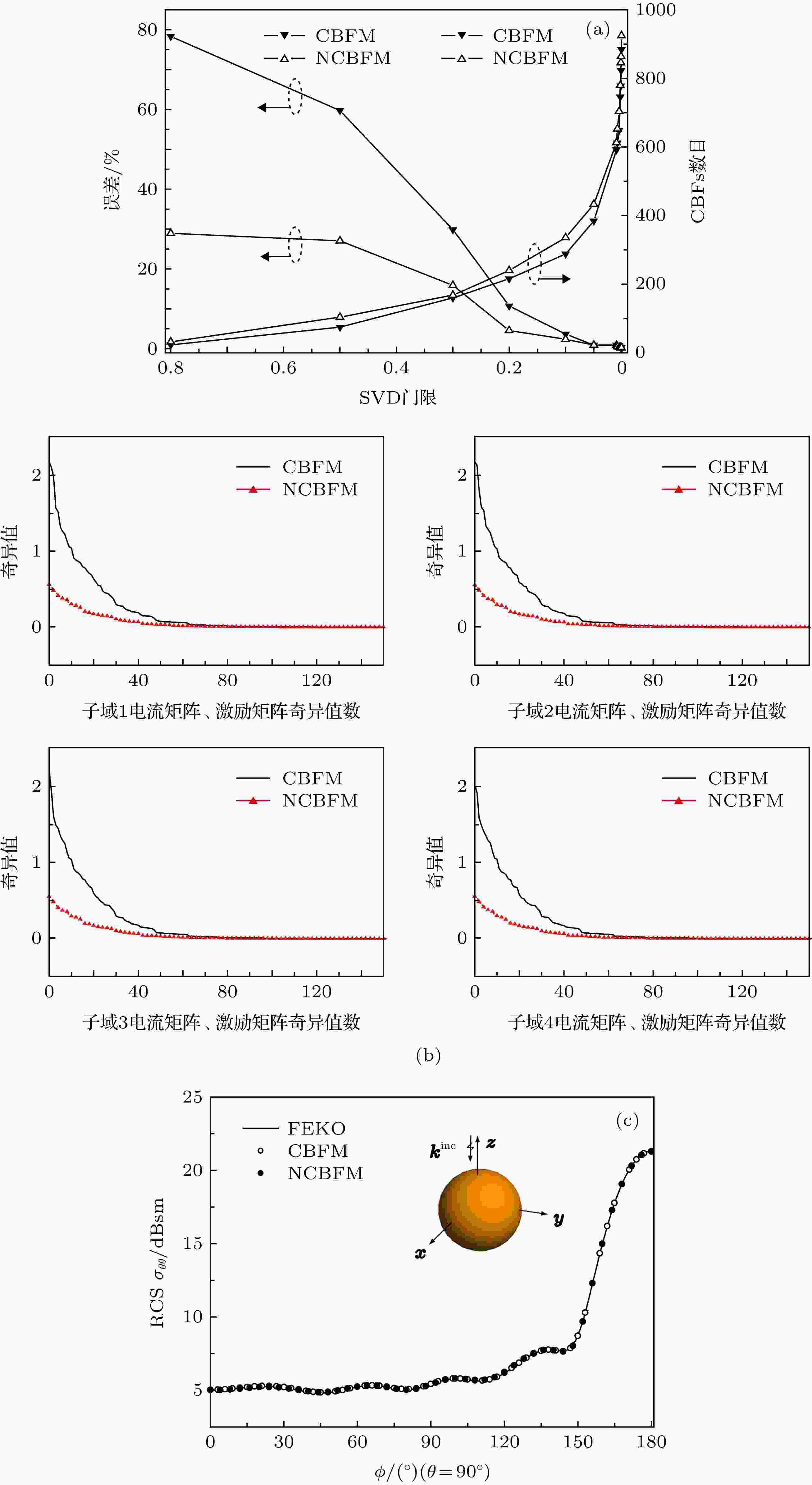
2019, 68 (17): 170201.
doi:10.7498/aps.68.20190572
Abstract +
The characteristic basis function method is known as an effective method to solve the electromagnetic scattering problems, but the convergence of the iterative solution of the reduced matrix equation is slow when the characteristic basis function method is used to analyze the electromagnetic scattering characteristics of the electrically large target. In order to mitigate this problem, a new reduced matrix construction method is proposed to improve the iterative solution efficiency of characteristic basis function method in this paper. Firstly, the singular value decomposition technique is used to compress the incident excitations, and the characteristic basis functions of each sub-domain under the new excitations are solved. Then, the new excitations and the characteristic basis functions are defied as the testing and basis functions to construct the reduced matrix. The diagonal sub-matrices of the reduced matrix constructed by the new testing and basis functions are all identity matrices, thereby improving the condition of reduced matrix. Thus, the total number of iterations to achieve reasonable results is significantly reduced. Numerical simulations are conducted to validate the performance of the proposed method. The results demonstrate that the efficiency of the iterative solution of the reduced matrix equation constructed by the new method is significantly improved. Furthermore, the characteristic basis functions’ generation time required by the proposed method is noticeably less than that by the traditional characteristic basis function method due to the reduced number of matrix equation solutions.
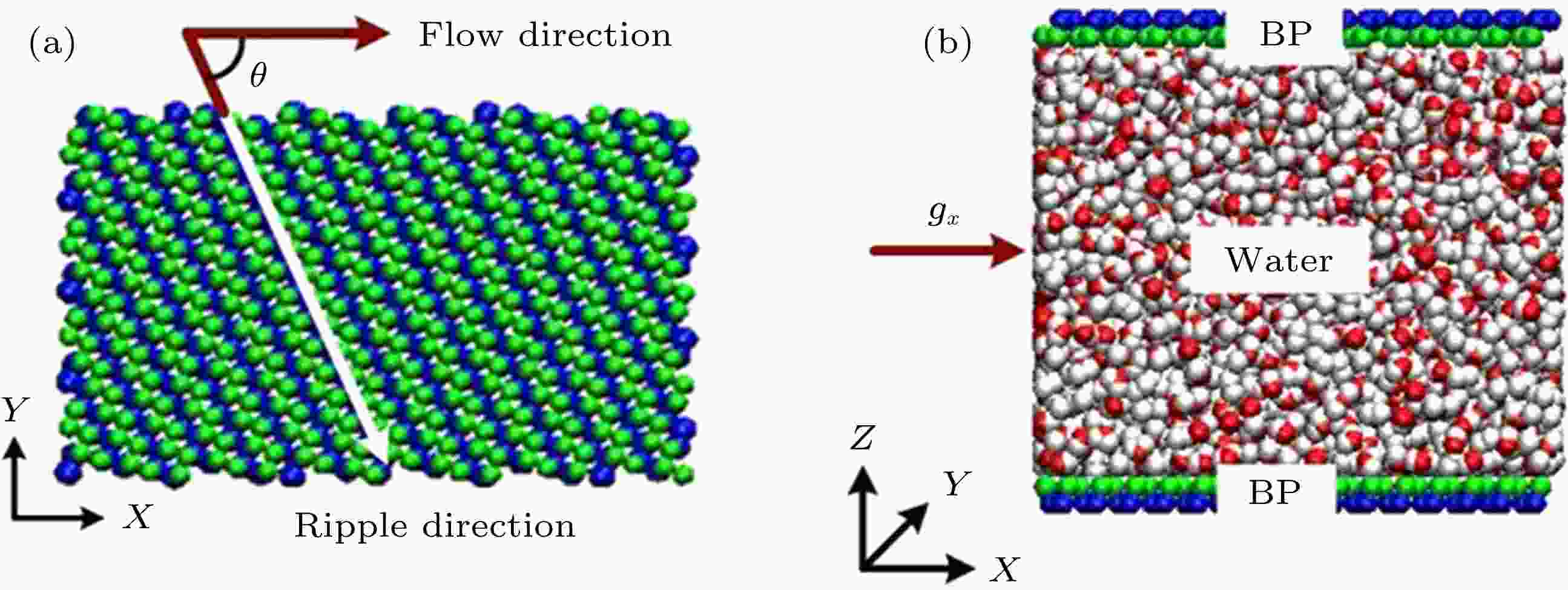
2019, 68 (17): 170202.
doi:10.7498/aps.68.20190531
Abstract +
With the rapid development of low-dimensional materials, the opportunity that promotes the development of micro/nano fluid devices, a new low-dimensional material black phosphorus (BP) has attracted wide attention due to its excellent properties, and has been applied to many areas. In this paper, the influences of driving force, water-BP anisotropy, channels’ width and the number of black phosphorus layers on the flow characteristics of water molecules in the nanochannels are studied by molecular dynamics based on the Poiseuille flow model. The results show that the boundary slip velocity increases with the driving force increasing. The anisotropy will also affect the flow characteristics of water molecules in the nanochannel under the pressure driving the Poiseuille flow. Specifically, the boundary slip velocity decreases with the chirality angle increasing, and the viscosity coefficient of water molecules is still not affected by the anisotropy. The natural rippled structure of the BP surface leads to the coarse potential surface, and further results in the anisotropic boundary slip and interfacial friction between water and BP sheets. With the driving acceleration kept constant, the influences of the width of nanochannels and the number of black phosphorus layers on the boundary slip velocity and viscosity coefficient of water molecules are investigated. The results indicate that the slip velocity of water molecules in the nanochannels decreases with the width of the nanochannels increasing. The velocity profile of water molecules in the bilayer model is slightly different from that in the monolayer model. With the number of BP layers increasing, the energy of BP-water solid-liquid interface increases while the anisotropic interfacial property remains unchanged. The results will provide a theoretical basis for the study of the characteristics of the fluid flowing in the black phosphorus nanochannels and the design of micro/nano fluid devices based on black phosphorus materials.
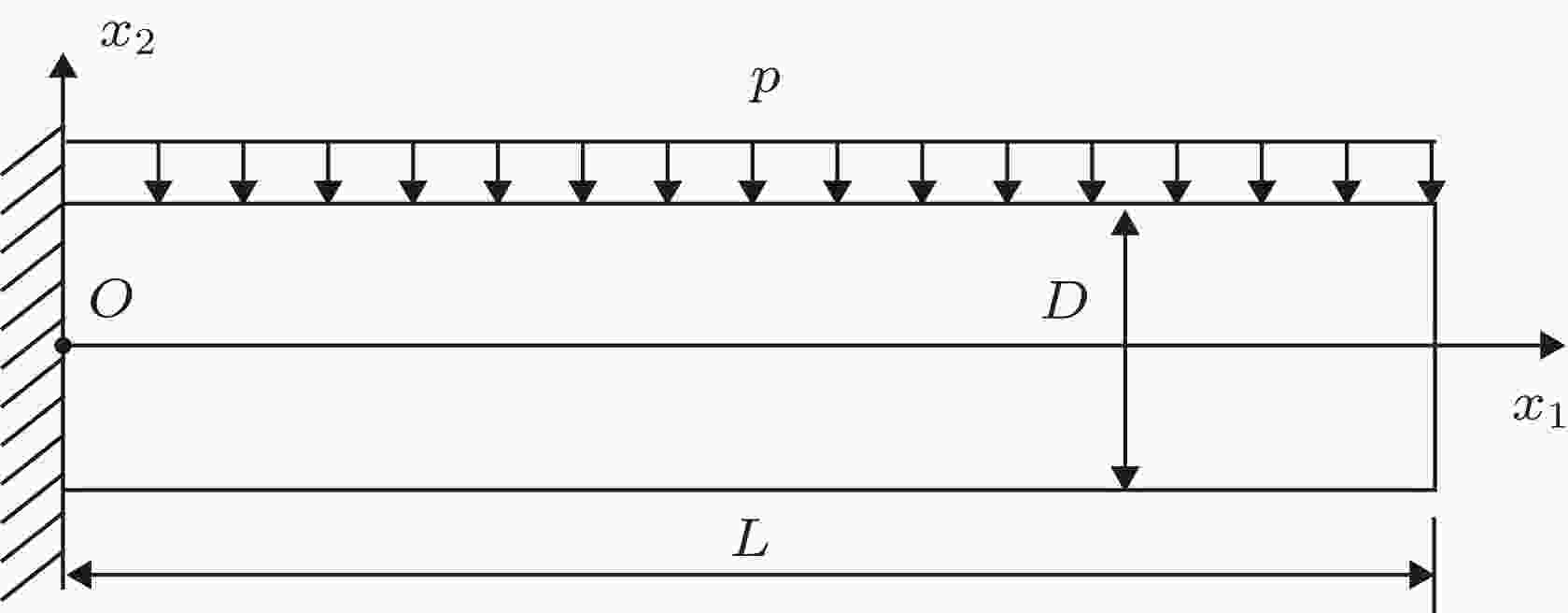
2019, 68 (17): 170203.
doi:10.7498/aps.68.20191047
Abstract +
In this paper, based on the improved interpolating moving least-square (IMLS) approximation, the interpolating element-free Galerkin (IEFG) method for two-dimensional viscoelasticity problems is presented. The shape function constructed by the IMLS approximation can overcome the shortcomings that the shape function of the moving least-squares (MLS) can-not satisfy the property of Kronecker function, so the essential boundary conditions can be directly applied to the IEFG method. Under a similar computational precision, compared with the meshless method based on the MLS approximation, the meshless method using the IMLS approximation has a high computational efficiency. Using the IMLS approximation to form the shape function and adopting the Galerkin weak form of the two-dimensional viscoelasticity problem to obtain the final discretized equation, the formulae for two-dimensional viscoelasticity problem are derived by the IEFG method. The IEFG method has some advantages over the conventional element-free Galerkin (EFG) method, such as the concise formulae and direct application of the essential boundary conditions, For the IEFG method of two-dimensional viscoelasticity problems proposed in this paper, three numerical examples and one engineering example are given. The convergence of the method is analyzed by considering the effects of the scale parameters of influence domains and the node distribution on the computational precision of the solutions. It is shown that whendmax= 1.01−2.00, the method in this paper has a good convergence. The numerical results from the IEFG method are compared with those from the EFG method and from the finite element method or analytical solution. We can see that the IEFG method in this paper is effective. The results of the examples show that the IEFG method has the advantage in improving the computational efficiency of the EFG method under a similar computational accuracy. And the engineering example shows that the IEFG method can not only has higher computational precision, but also improve the computational efficiency.
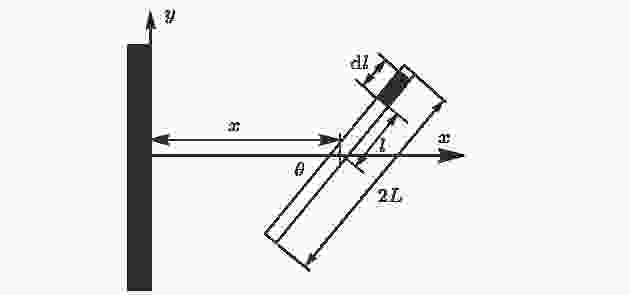
2019, 68 (17): 170501.
doi:10.7498/aps.68.20190435
Abstract +
Self-driven particle systems consist of particles that can extract energy from the environment and transform into active motion, and thus are significantly different from the classical passive particle systems. For such an active system, the question of whether there is a classical equation of state (EOS) has caused spreading concern. Recent studies analyzed the validity of the EOS of an active system under the harmonic potential (Solon et. al, 2015Nature Physics,11673). In contrast, this paper explores the conditions for and the specific forms of the EOS of an active system under electric double-layer interaction between the wall and the particles. The results show that the wall pressure is related to the shape of the active particles. When a wall exerts a moment on the active particles, the particles orientation turns to the equilibrium state parallel to the wall surface under the action of the moment, and the increase of the wall-particle interaction strength enhances the parallel-orientation trend, which reduces the system pressure. The association of pressure and wall means that the active system does not have a general equation of state. In the case where the wall-particle interaction intensity is extremely small or extremely large, by defining the effective temperature, the active system has an equation of state similar to that of the ideal gas. In addition, it is found that the extent of the shape of particles deviating from the rotational symmetry is a key factor affecting the pressure of active particles. The research results provide a reference for the study of the current active system equilibrium properties, and provide a basis for studying the thermodynamic properties of active systems under more complex interaction potentials.
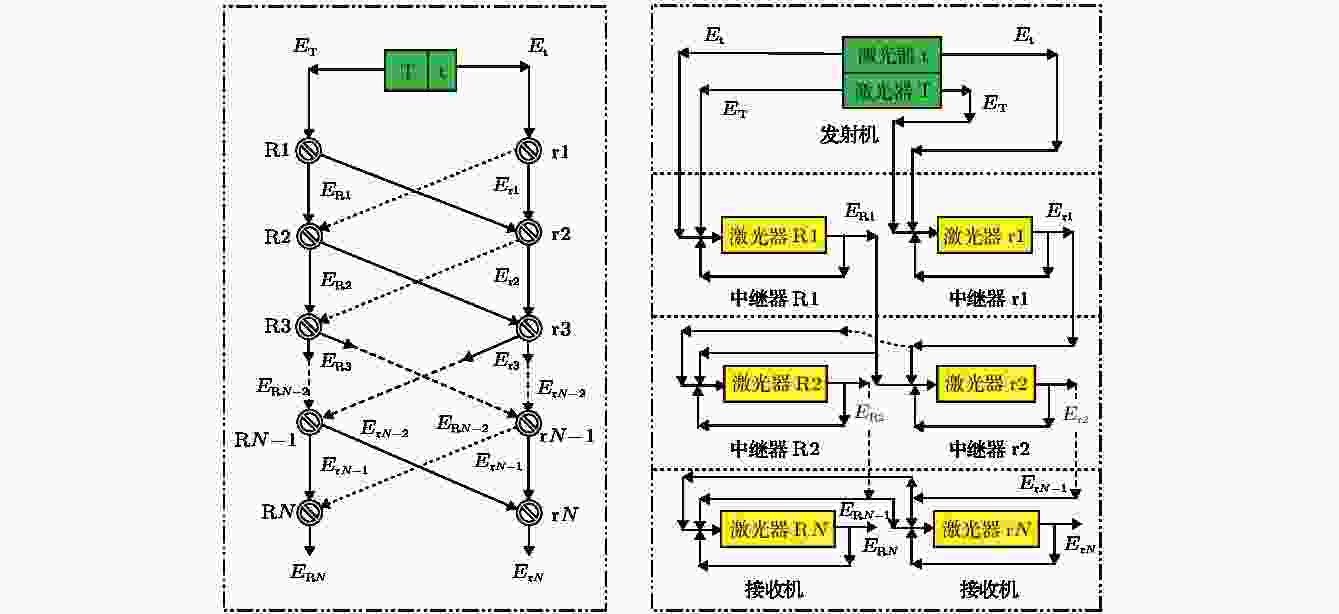
2019, 68 (17): 170502.
doi:10.7498/aps.68.20190212
Abstract +
In this paper, chaotic parallel synchronization and quasi-periodic parallel synchronization between two mutually coupled different semiconductor lasers and other lasers are studied, and the regeneration of chaotic laser and key technology of repeater are discussed. The complex dynamic system and network of laser parallel series are presented in mathematics and in physics, and the network topology diagram and optics path are specified. A mathematical-physical model is given to study how to obtain parallel synchronization via the coupled driving nonlinear equations. The operating principle of the repeater is put forward for chaotic secure communication, and the channel equation of repeater is established because the laser chaotic behavior is extremely sensitive to external influences and system parameter changes. The laser’s chaotically regenerating and transmitting is successfully realized via two sets of repeaters. The chaotic encoding communication with repeaters is successfully completed while the encoding information signal is accurately extracted from the chaotic carrier by a filter and calculating the synchronous difference. We adopt three sets of lasers as a research case to simulate and verify the theory of laser parallel series network we put forward to fit perfectly the obtained numerical results. We study the parameter mismatch problem of the system, where the synchronous difference is numerically calculated by varying some parameters of the lasers. In the case of smaller parameter mismatch, the system has a highly synchronous capability to a certain degree. This is a novel laser chaotic encoding network in chaotic secure communication and characterizes the core technical elements of the repeater. The laser transmitter has four nonlinear interaction variables, where the nonlinear interaction between the amplitude and phase of the two optical fields results in highly nonlinear dynamics. The system has the characteristics of high nonlinearity, multi-variable, high-dimension, and multi-key. So it is highly secure and not easy to crack. The results have an important reference value for the chaos applications in remote secure communication, optical network and laser technology.
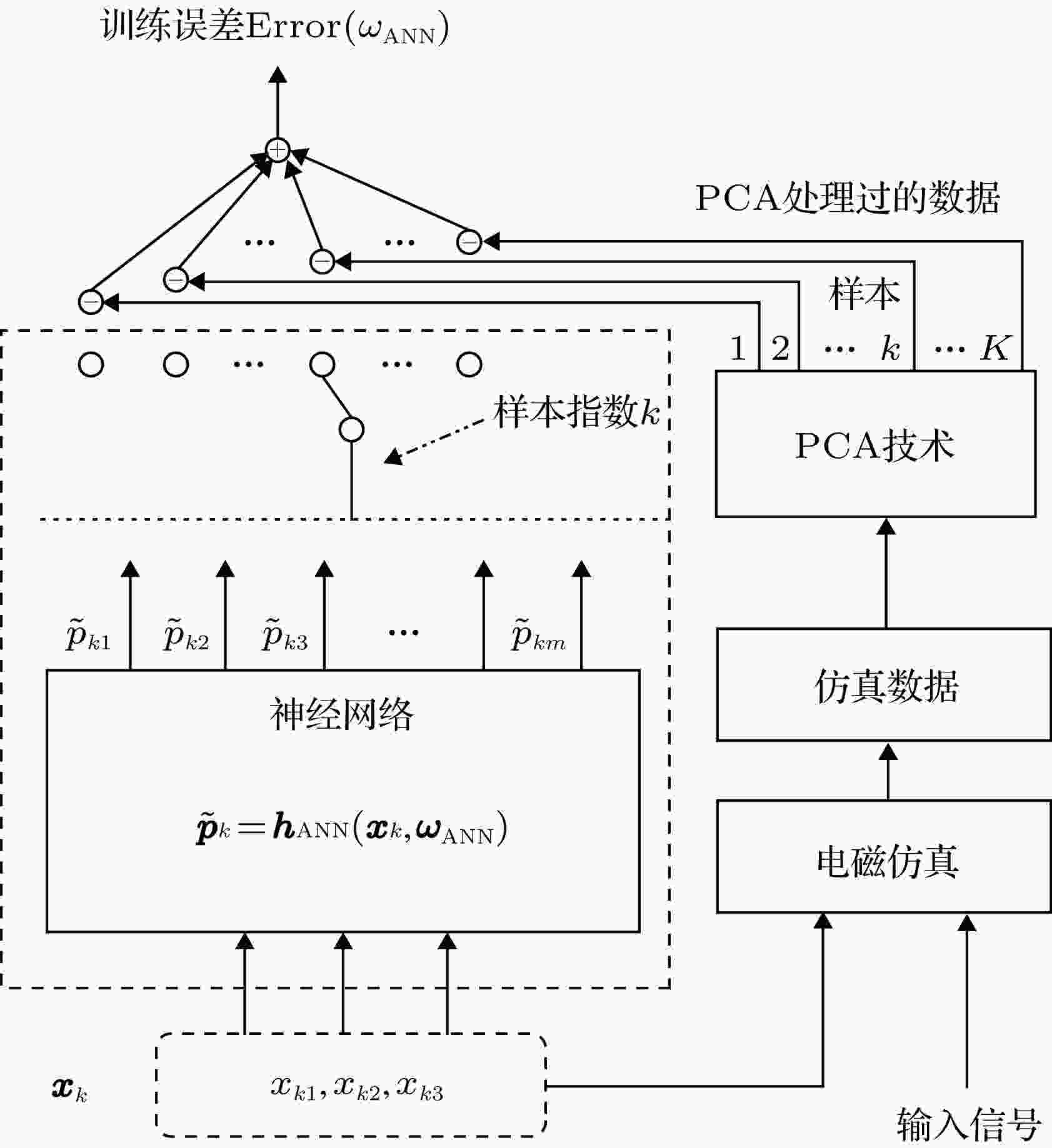
2019, 68 (17): 170503.
doi:10.7498/aps.68.20190327
Abstract +
Because of the strong non-linear fitting capability, the artificial neural network (ANN) can be used to establish the mapping relationship between the terminal position and the received signal for obtaining the channel characteristics at different locations. The accuracy of an ANN model is, in general, determined by the number of the training sets used in constructing the model. The more the training sets, the better the accuracy is. However, getting a large number of training sets by deterministic model is expensive. Therefore, under the same number of training sets, improving the accuracy of the model is crucial to develop an effective time reversal (TR) modeling method based on ANN. In this paper, a new TR channel modeling method based on the back propagation neural network is proposed. Genetic algorithm (GA) with excellent global search capability is used to optimize the weight and threshold of the ANN to avoid the possibility of the ANN falling into local minimum. According to the basic principle of time reversal, the peak characteristics are obtained by the fitting method. In order to improve the accuracy of the model, the peak value characteristics are integrated into the GA as empirical knowledge to change the fitness function. Meanwhile, the principal component analysis technology is utilized to process data, which reduces the data dimension and the training time of ANN while data characteristics are ensured. Once the terminal antenna positions are input to the proposed model, the accurate TR received signals can be quickly obtained. Finally, the deconvolution operation of the received signal is performed by the clean algorithm to obtain the channel characteristics. A simple indoor TR scenario is used as an example to demonstrate the effectiveness of the proposed method. The results show that the three channel characteristics obtained by the model, i.e., channel impulse response peak value, 15 dB multipath number, and average delay, have high accuracy. Furthermore, the proposed model has more excellent performance than the other two ANN models under the condition of the same number of training samples. Based on the basic principle of TR technology, the electromagnetic waves have better focusing effect in more complex environments. Therefore, the proposed method is also applicable to more complicated environments than the simple indoor scenario.
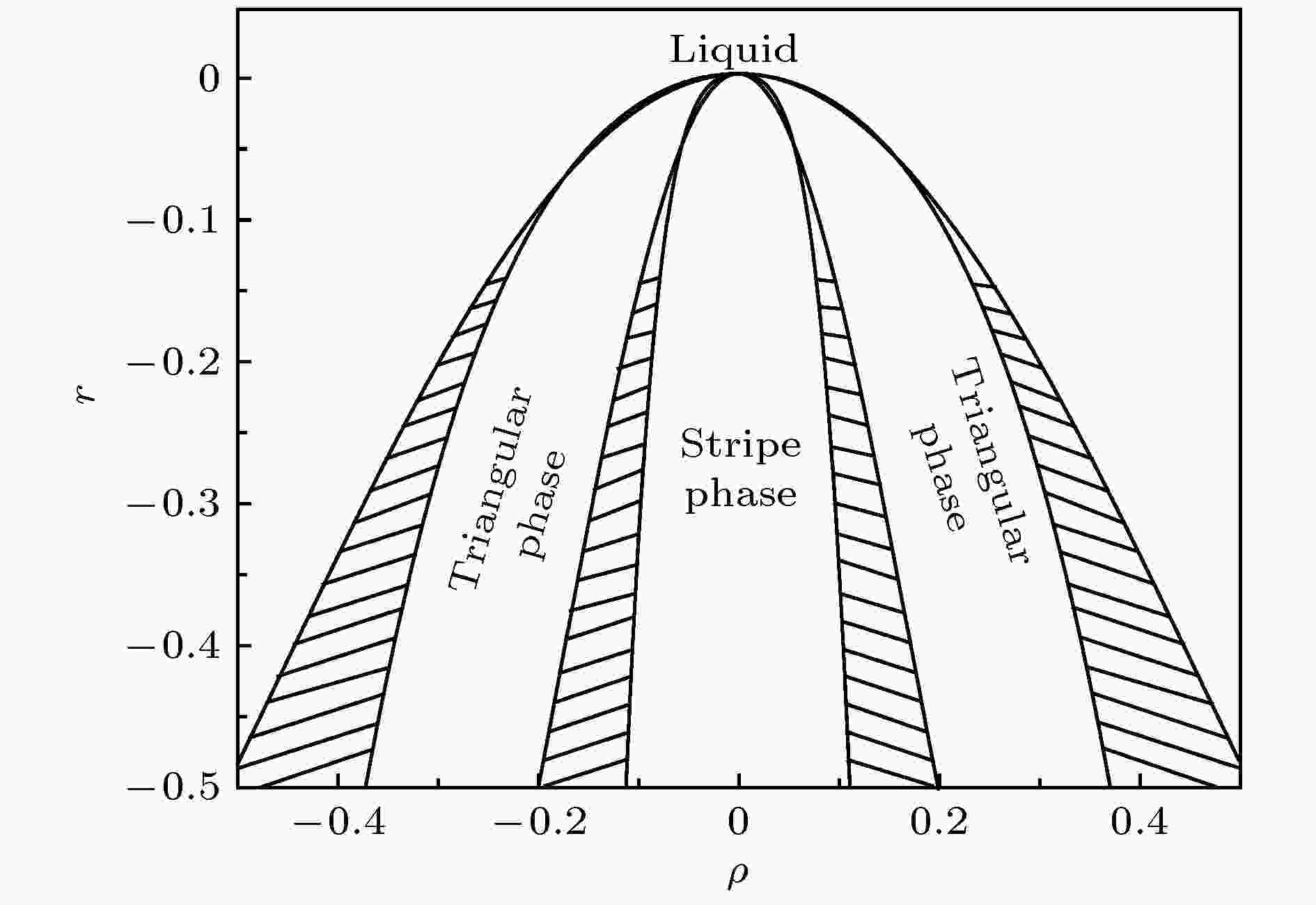
2019, 68 (17): 170504.
doi:10.7498/aps.68.20190051
Abstract +
For crystal materials, the grain boundary structure is complex, which is usually the place in which stress concentration and impurity accumulate. Grain boundary structure and movement have a great influence on the macroscopic properties of crystal materials, therefore, it is of great significance to study the microstructure of grain boundary. With the phase filed crystal approach, the structure of low-angle symmetric tilt grain boundary and dislocation motion at nanoscale are studied. The low-angle symmetric tilt grain boundary structure can be described by a dislocation model, in which the grain boundary can be regarded as consisting of a series of edge dislocations at a certain distance. For a relaxation process and applied stress process, the position change of dislocation motion at grain boundaries and the change of free energy density of the system are observed. Furthermore, we also analyze the influence of temperature on the grain boundary structure and the dislocation motion. In the relaxation process, the free energy of the crystal system is higher under high temperature conditions. The results show that the motion of dislocation pairs in the grains can consume the internal energy and release the distortion energy stored at the grain boundary, and thus making the system more stable and the energy reach the lowest value earlier. Simulation results show that the lower the temperature of the system, the faster the free energy density decreases, the faster the regular arrangement rate of atoms increases, the shorter the time required for the free energy density to reach a stable state becomes. And when the grain boundary reaches a steady state, the arrangement of the dislocations becomes more and more regular and arranges in a straight line. For an applied stress process, with the decrease of temperature, the time required for the first encounter of dislocation pairs and the time required for the formation of single crystal become longer, and it takes more time for the first encounter of dislocation pairs in crystals to disappear completely. Further studies also show that with the decrease of temperature, the free energy density exhibits a multi-stage ascending and descending process. The rising process of energy curve corresponds to the stage of dislocation climbing along the grain boundary, and the decline process corresponds to the stage of dislocation decomposition and encounter annihilation. At the same time, the dislocation pairs’ reaction becomes more complex. Finally, the dislocations annihilate with each other.

2019, 68 (17): 170701.
doi:10.7498/aps.68.20190205
Abstract +
Radiation pressure in an optomechanical system can be used to generate various quantum phenomena. Recently, one paid more attention to the study of optical nonreciprocity in an optomechanical system, and nonreciprocal devices are indispensable for building quantum networks and ubiquitous in modern communication technology. Here in this work, we study how to realize the perfect optical nonreciprocity in a two-cavity optomechanical system with blue-detuned driving. Our calculations show that the optical nonreciprocity comes from the quantum interference of signal transmission between two possible paths corresponding to the two interactions in this system, i.e. optomechanical interaction and linearly-coupled interaction. According to the standard input-output relation of optical field in cavity optomechanics, we obtain the expression of output optical field, from which we can derive the essential conditions to achieve the perfect optical nonreciprocity, and find there are two sets of coupling strengths both of which can realize the perfect optical nonreciprocal transmission. Because the system is driven by blue-detuned driving, the system is stable only under some conditions which we can obtain according to the Routh-Hurwitz criterion. Due to the blue-detuned driving, there will be transmission gain (transmission amplitude is greater than 1) in the nonreciprocal transmission spectrum. We also find that the bandwidth of nonreciprocal transmission spectrum is in proportion to mechanical decay rate if mechanical decay rate is much less than the cavity decay rate. In other words, in a realistic optomechanical parameter regime, where mechanical decay rate is much less than cavity decay rate, the bandwidth of nonreciprocal transmission spectrum is very narrow. Our results can also be applied to other parametrically coupled three-mode bosonic systems and may be used to realize the state transfer process and optical nonreciprocal transmission in an optomechanical system.
ATOMIC AND MOLECULAR PHYSICS
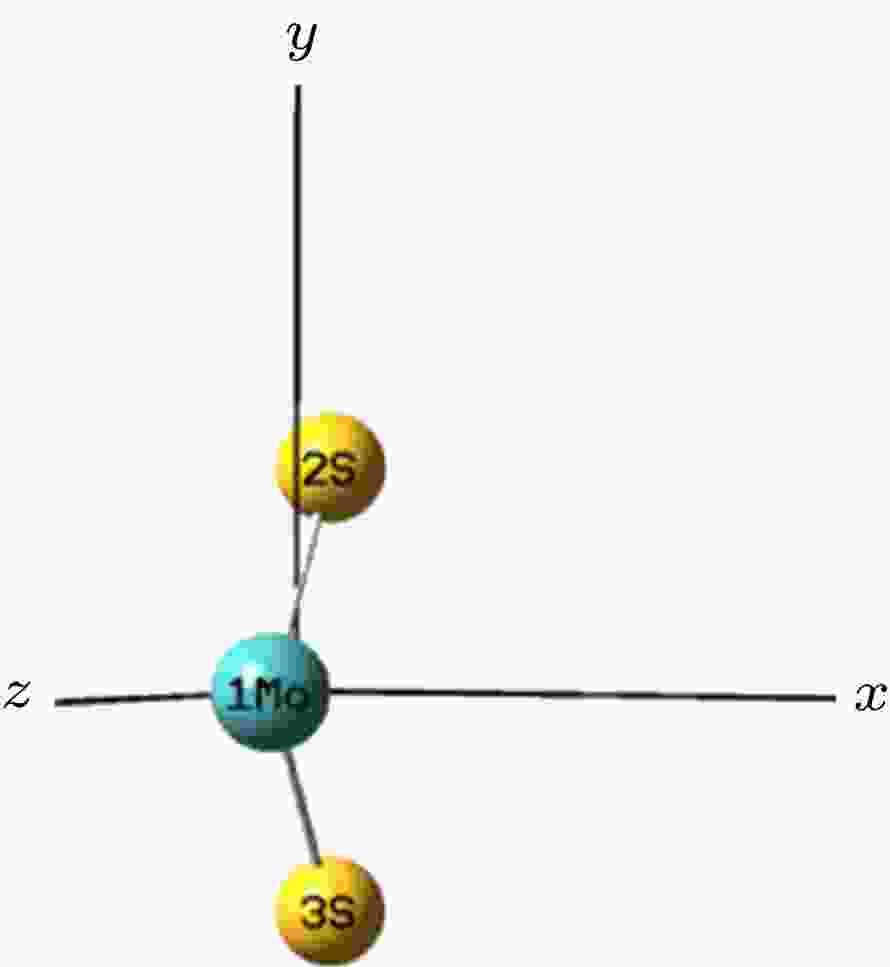
2019, 68 (17): 173101.
doi:10.7498/aps.68.20190781
Abstract +
A variety of new materials have improved the production and life of human beings. Two-dimensional nano materials have become a research hotspot due to their unique physical and chemical properties. Molybdenum disulfide (MoS2) is representative of transition metal sulfide, with excellent mechanical properties and chemical stability. In order to study the influence of external electrical field on the molecular structure and spectrum, here in this work, the density functional theory with the hybrid B3LYP at Def2-TZVP level is employed to calculate the geometrical parameters of the ground state of MoS2molecule under external electric fields ranging from 0 to 0.1 a.u. (0−5.1423 × 1010V/m). Based on the optimized structures, the time-dependent density functional theory at the same level as the above is adopted to calculate the absorption wavelengths and the molar absorption coefficients for the first ten excited states of MoS2molecule under external electric fields. The results show that the most strongest absorption band is located at 483 nm with a molar absorption coefficient of 461 L·mol–1·cm–1in the UV-Vis absorption spectrum. The intramolecular charge transfers as a whole with the enhancement of the external electric field. The electric dipole moment increases with the external electric field rising, while the total molecular energy decreases with external electric field increasing. With the enhancement of the external electric field, the absorption peaks show a significant redshift. When the electric field increases to 0.1 a.u., the redshift is obvious. This can be explained as follows. When the external electric field is weaker, the electron transfer in the molecule is not significant. However, with the augment of the external electric field, the electron transfer in the molecule occurs as a whole. This makes the electron interaction between Mo and S weaker, thus the electron transition is more likely to occur. The energy required for excitation is reduced, and the wavelength of the excited state becomes longer, that is, the absorption peak takes a redshift. With the enhancement of the external electric field, the molar absorption coefficient increases obviously. This is because the overall transfer of the external electric field to the electron makes the electron cloud density of the MoS2molecule increase and the number of electrons in transition augment. This work provides a theoretical basis for the utilization and improvement of MoS2photoelectric properties, and also enlightens the application research of other photoelectric materials.
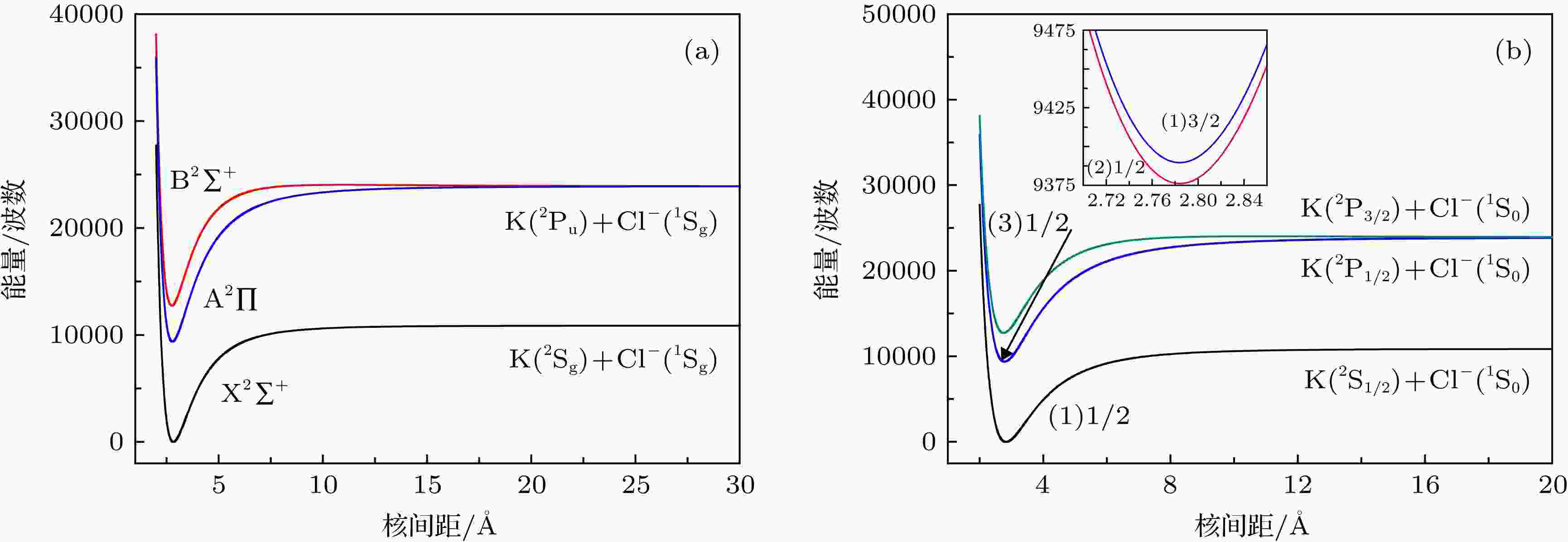
2019, 68 (17): 173102.
doi:10.7498/aps.68.20190869
Abstract +
The potential energy curves and transition dipole moments (TDMs) for three Λ-S states (X2Σ+, A2Π, and B2Σ+) of potassium chloride anion (KCl–) are investigated by using multi-reference configuration interaction (MRCI) method. The def2-AQZVPP-JKFI of K atom and AV5Z-DK all-electron basis set of Cl atom are used in all calculations. The Davidson correction, core-valence (CV) correction, and spin-orbit coupling effect (SOC) are also considered. In the complete active self-consistent field (CASSCF) calculations, eight molecular orbitals are selected as active orbitals, which includ K 4s4p and Cl 3s3p shells; K 3p shell is closed orbital, and the remaining shells (K 1s2s3s and Cl 1s2s2p) are frozen orbitals. In the MRCI+Qcalculations, K 3p shell is used for the CV correction. There are 15 electrons in the correlation energy calculations. Then, their spectroscopic parameters, Einstein coefficients, Franck-Condon factors, and radiative lifetimes are obtained by solving the radial Schrödinger equation. The spectroscopic properties and transition properties for the Ω states are predicted. Highly diagonally distributed Franck-Condon factorf00values for the (2)1/2↔(1)1/2 and (1)3/2↔(1)1/2 transition are 0.8816 and 0.8808, respectively. And the short radiative lifetimes for the (2)1/2 and (1)3/2 excited states are also obtained, i.e.τ[(2)1/2] = 45.7 ns andτ[(1)3/2] = 45.5 ns, which can ensure laser cooling of KCl–anion rapidly. The results indicate that the (2)1/2↔(1)1/2 and (1)3/2↔(1)1/2 quasicycling transitions are suitable to the building of laser cooling projects. For driving the (2)1/2↔(1)1/2 transition, a main pump laser (λ00) and two repumping lasers (λ10and λ21) are required. Their wavelengths are λ00= 1065.77 nm, λ10= 1090.13 nm and λ21= 1087.76 nm. For driving the (1)3/2↔(1)1/2 transition, the wavelengths are λ00= 1064.24 nm, λ10= 1088.54 nm, and λ21= 1086.17 nm. The cooling wavelengths of KCl-anion for two transitions are both deep in the infrared range. Finally, the Doppler temperature and recoil temperature for two transitions are also calculated, respectively. The Doppler temperatures for (2)1/2↔(1)1/2 and (1)3/2(1)1/2 transitions are 83.57 μK and 83.93 μK, and the recoil temperatures for two transitions are 226 nK and 227 nK, respectively. for two transitions are 226 nK and 227 nK, respectively.

2019, 68 (17): 173201.
doi:10.7498/aps.68.20190143
Abstract +
Rabi model is a popular model in quantum optics and describes a two-level system coupling to a quantum resonator. The fruitful physics appears when the coupling strength is comparable to the frequency of the resonator. We investigate the Bose gases of Raman induced spin-orbit coupling with an external harmonic trapping. Using the displacement Fock state in quantum optics we seek for an approximate ground state. We find the superposition state of left and right displaced oscillator state with odd parity has lower energy than the displaced state itself. Besides, we study the time evolution of both the momentum and the position of the system at single particle level to demonstrate the Zitterbewegung oscillating characteristics, which present an intuitive physical picture and are in qualitative agreement with the relevant experimental results. The results are useful to study the Rabi model in deep-strong coupling regime, the model that is difficult to realize in today’s experiment based on the high controllability property of laser, and these results are also instructive for the cold atom physics field.
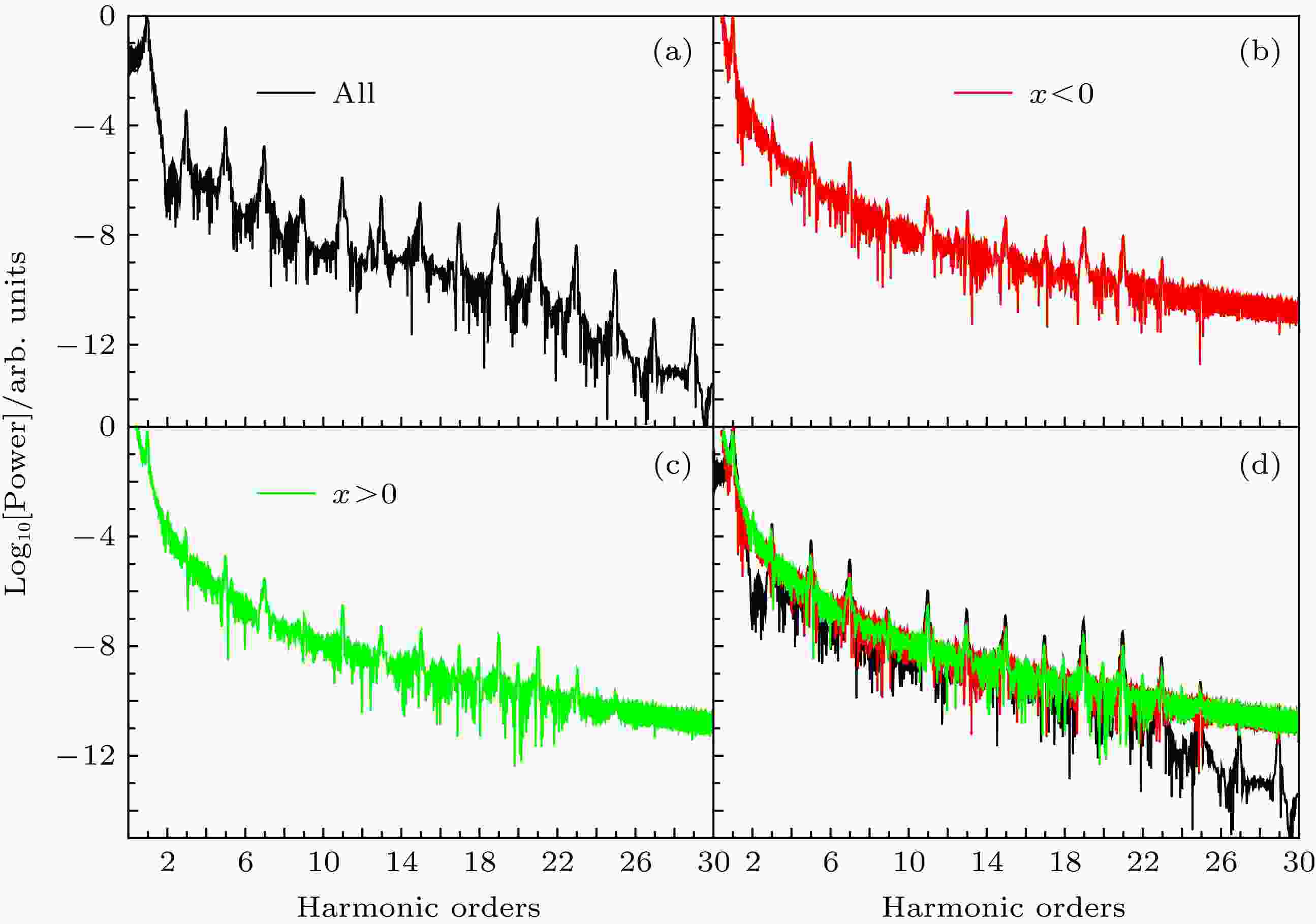
2019, 68 (17): 173202.
doi:10.7498/aps.68.20190790
Abstract +
ELECTROMAGNETISM, OPTICS, ACOUSTICS, HEAT TRANSFER, CLASSICAL MECHANICS, AND FLUID DYNAMICS
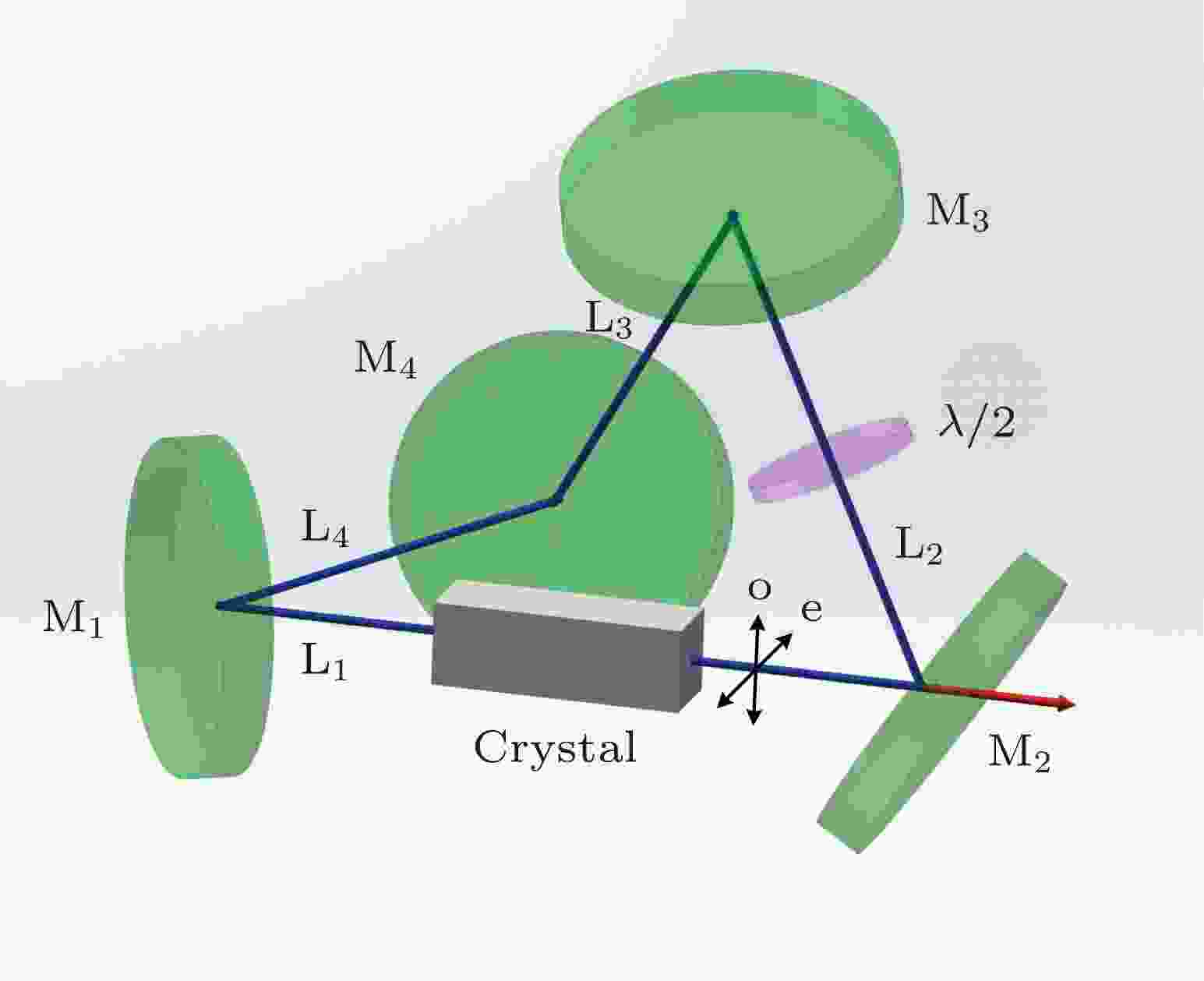
2019, 68 (17): 174201.
doi:10.7498/aps.68.20182001
Abstract +
Mid-infrared optical parametric oscillator (OPO) operating in the mid-infrared transmission window (3—5 μm wavelength range) is one of hot issues in the field of laser system. It has many applications in environmental detection, remote sensing, and medicine. Besides, this laser system is used as a key component of infrared countermeasures. The optical damage limit of nonlinear crystal is a great challenge to the mid-infrared OPO which is pumped by a nanosecond laser source. Therefore, the pump beam diameter should be appropriately increased to avoid damaging the crystal when scaling a nanosecond OPO to high pulse energy. The result of this design is that the Fresnel number in the cavity is increased and the beam quality is deteriorated. In order to improve the beam quality of mid-infrared OPO laser, a 90°image-rotating four-mirror non-planar ring resonator structure is designed. The advantages of this design include the general ring resonators, such as greatly reduced feedback into the pump laser and the avoidance of optical damage caused by standing wave cavity structure. Most importantly, the image rotating cavity can uniform the beam in the cavity and improve the beam quality. In this paper, the equivalent sphere representation of a four-mirror nonplanar ring resonator is established, and the image rotation angle of this special cavity structure is calculated. Based on this method, the parameters related to the 90°image rotating resonator structure suitable for mid-infrared OPO operation are designed. The self-reproduction of the transverse mode in the axially-asymmetric resonator is further established. It is found that the transverse mode in the resonator is gradually uniformed as the rotation angle of the image changes from 0°to 90°. When the rotation angle is 90°, the fundamental mode and the high-order mode both exhibit very good central symmetry. Finally, the mid-infrared ZnGeP2 OPO laser with the 90°image rotating resonator structure is used to verify the improvement of beam quality. The beam quality of
$M_X^2=1.81 $
and
$M_Y^2=1.61$
are achieved. It can be proved that the 90°rotating four-mirror non-planar ring resonator has a significant effect on the optimization of the output beam quality of the mid-infrared OPO laser system.

2019, 68 (17): 174202.
doi:10.7498/aps.68.20190078
Abstract +
All-optical diodes and all-optical transistors are the basis of all-optical logic devices. We study the quantum statistical properties of all-optical diodes based on cavity quantum electrodynamics (QED)[
1
], and discuss the squeezed properties of the output light after passing through the diode when coherent light and squeezed light are incident. Here we extend our research to all-optical transistor, and take all-optical transistor based on cavity optomechanical system as the research object. By changing the intensity of classical pump light, the all-optical transistor can effectively control the output of the probe light and realize optical amplification. We discuss the squeezed properties of the output light of the all-optical transistor with squeezed light and coherent light as the probe light. Our results show that when the probe light is coherent, the output light remains coherent no matter whether it works in the amplified region, and is not squeezed. When the input probe light is amplitude squeezed light, the output light is still squeezed light in the light amplification region of all-optical transistor, but the squeezed properties are modulated by the input light squeezed properties and system parameters. When the squeezed angle of the input probe squeezed light is 0°, the minimum squeezed parameter S1of the output squeezed light decreases with the increase of the squeezed coefficient r of the input probe light, and the minimum value approaches to the squeezed limit of –0.25. But the change of squeezed angle of the input probe squeezed light changes has a great influence on the squeezed parameter S1,2of the output light, and the squeezed properties will disappear. Only when the squeezed angle is an integer multiple of π, will the squeezed properties of the output light be best. This result has a potential application value in quantum measurement, weak signal detection, and other fields.

2019, 68 (17): 174203.
doi:10.7498/aps.68.20190151
Abstract +

2019, 68 (17): 174204.
doi:10.7498/aps.68.20190441
Abstract +
A series of the hexagonal-phase NaLuF4:20.0%Yb3+/2.0%Ho3+/12.0% Ce3+@NaLuF4:x%Yb3+core-shell (CS) nanocrystals with codoping different Yb3+ions in the shell is successfully built by a sequential growth process. The crystal structures and morphologies of samples are characterized by X-ray diffractometer and transmission electron microscope. With the Yb3+ion concentration increasing from 0% to 15% in NaLuF4shell, none of the crystal structures, sizes, and morphologies of the samples changes obviously because of the similarity in ionic radius between Yb3+and the ions in shell and the low doping concentration. Under 980 nm near-infrared (NIR) excitation, the NaLuF4:20.0%Yb3+/2.0%Ho3+/12.0%Ce3+core nanocrystal produce green and red UC emission. And the red UC emission intensity is higher than green emission intensity. This is because two effective cross-relaxation processes happen between Ho3+and Ce3+ions, which results in the enhancement of the red emission. However, the overall emission intensity of NaLuF4:20.0%Yb3+/2.0%Ho3+/12.0%Ce3+nanocrystal decrease compared with that of the NaLuF4:20.0%Yb3+/2.0%Ho3+nanocrystal. Thus, to further enhance the red UC emission intensity in NaLuF4:20.0%Yb3+/2.0%Ho3+/12.0%Ce3+nanocrystal, the NaLuF4:20.0%Yb3+/2.0% Ho3+/12.0%Ce3+@NaLuF4:x%Yb3+CS nanocrystal are prepared for blocking the excitation and emission energy, transmitting surface quenching center and getting more excitation energy through doping Yb3+ions in NaLuF4shell. It can be clearly seen that the red UC emission intensity of CS nanocrystal first increases and then decreases with Yb3+ion concentration increasing. Meanwhile, the corresponding red-to-green ratio increases from 4.9 to 5.6. The highest red UC emission intensity is observed in each of the NaLuF4:20.0%Yb3+/2.0%Ho3+/12.0%Ce3+@NaLuF4:10%Yb3+CS nanocrystal because the Ho3+ions get more energy through the following three ways: 1) Yb3+(core)-Ho3+(core); 2) Yb3+(shell)-Ho3+(core); 3) Yb3+(shell)-Yb3+(core)-Ho3+(core). Thus, building CS nanocrystals is one of the most effective approaches in order to improve the UC efficiency by suppressing the non-radiative decay of activators in the core and getting more excitation energy through different energy transfer ways. These NaLuF4:20.0%Yb3+/2.0%Ho3+/12.0%Ce3+@NaLuF4:Yb3+CS nanocrystals with red UC emission have great potential applications in biological field and multi-primary color.

2019, 68 (17): 174301.
doi:10.7498/aps.68.20190700
Abstract +
In this paper, two generalized likelihood ratio (GLR) detectors are presented for the case of multiple snapshots of test data to detect the presence of an underwater acoustic source in the deep ocean. The two GLR detectors are termed the eigenvalue detector (EVD) and the constant false alarm rate eigenvalue detector (CFAR EVD), respectively. Theoretical analysis and numerical results show that for a given input signal-to-noise ratio (SNR) of the array, the GLR detectors achieve higher output SNRs when the spatial dimension of test data decreases. To further enhance the detection performances of the GLR detectors, we propose a dimension-reduced (DR-GLR) method based on array sampling of modal information. This DR-GLR method combines the characteristics of sound propagation and array receiving. According to normal mode theory, acoustic signals emitted from the acoustic source lie in the modal space spanned by the sampled modal information of the array. Resulting from the restriction of the array size, it often occurs in deep ocean when the dimension of " effective modal subspace” is less than that of the test data which is equivalent to the number of hydrophones. Based on this phenomenon, we reconstruct the modal information by merely retaining the " effective modal subspace” to formulate the dimension reduction matrix. The DR-GLR test statistics is deduced by employing the dimension reduction matrix when using the vertical linear array (VLA) and the horizontal linear array (HLA), respectively. The DR-GLR detectors when using an HLA require more computational amount than when using a VLA. Simulation experiments are conducted to analyze the detection performances of the two GLR detectors, and verify the performance improvement effects of DR-GLR detectors. The numerical results show that the CFAR EVD presents good robustness to the uncertainty of the noise power and the DR-GLR detectors outperform the GLR detectors in detection performance. It also turns out the acoustic signals received by the HLA lie in a lower-dimensional " effective modal subspace” than by the VLA, and thus when using an HLA the DR-GLR detectors present higher detection probabilities than using a VLA. Moreover, the smaller the dimension of the " effective modal subspace”, the better the performance improvement of the DR-GLR detectors will be. The dimension of the " effective modal subspace” increases with hydrophone spacing and/or the source frequency increasing.

2019, 68 (17): 174701.
doi:10.7498/aps.68.20190683
Abstract +
Mixing enhancement for supersonic mixing layer is of great importance for developing scramjet engine. The growth rate of supersonic mixing layer is smaller than that of subsonic mixing layer. As the compressibility increases, the mixing enhancement becomes more difficult. Plasma synthetic jet is regarded as a promising flow control technology. The plasma synthetic jet generator can produce high energy jet. This generator has no moving parts and does not need additional gas source. It is the first time that plasma synthetic jet has been used to enhance the mixing in supersonic mixing layers. The influence of plasma synthetic jet on the supersonic mixing layer is investigated experimentally and numerically. The experiments are conducted in the low noise supersonic mixing layer wind tunnel. The Mach number of upper stream and lower stream are 1.37 and 2.39 respectively. The convective Mach number of this wind tunnel is 0.32. The plasma synthetic jet actuators are installed in the splitter plate. The distance between the jet hole and the splitter plate end is 15 mm. The nanoparticle-based planar laser scattering (NPLS), particle image velocimetry (PIV) and schlieren are used to obtain the response of the supersonic mixing layer to single pulse plasma synthetic jet perturbation. The NPLS successfully captures the large-scaled vortex structures induced by the plasma synthetic jet in the supersonic mixing layers. The effect of plasma synthetic jet is remarkable. The schlieren images show the process of the perturbation. An oblique shock wave is generated when the jet is ejected. The PIV is employed to obtain the influence of plasma synthetic jet on the velocity field. They-velocity standard deviation increases due to the perturbation. The actuators’ mixing enhancement effects and actuators’ performances at three locations are investigated by two-dimensional numerical simulation. The three actuators are located on the upper, bottom and end surface of splitter plate respectively. The numerical simulation results show that the mixing layer thickness is increased by the plasma synthetic jet perturbation. There are two mechanisms of perturbations while actuators are located at different positions. The actuators installed on the upper and bottom surface of splitter plate influence the mixing layer through perturbing the upper and lower stream respectively. The actuator installed at the end of splitter plate affects the mixing layer directly. The response time of supersonic mixing layers to the perturbation of the actuator installed at the end of splitter plate is shorter than those of the others. The performance of each actuator is sensitive to the location.
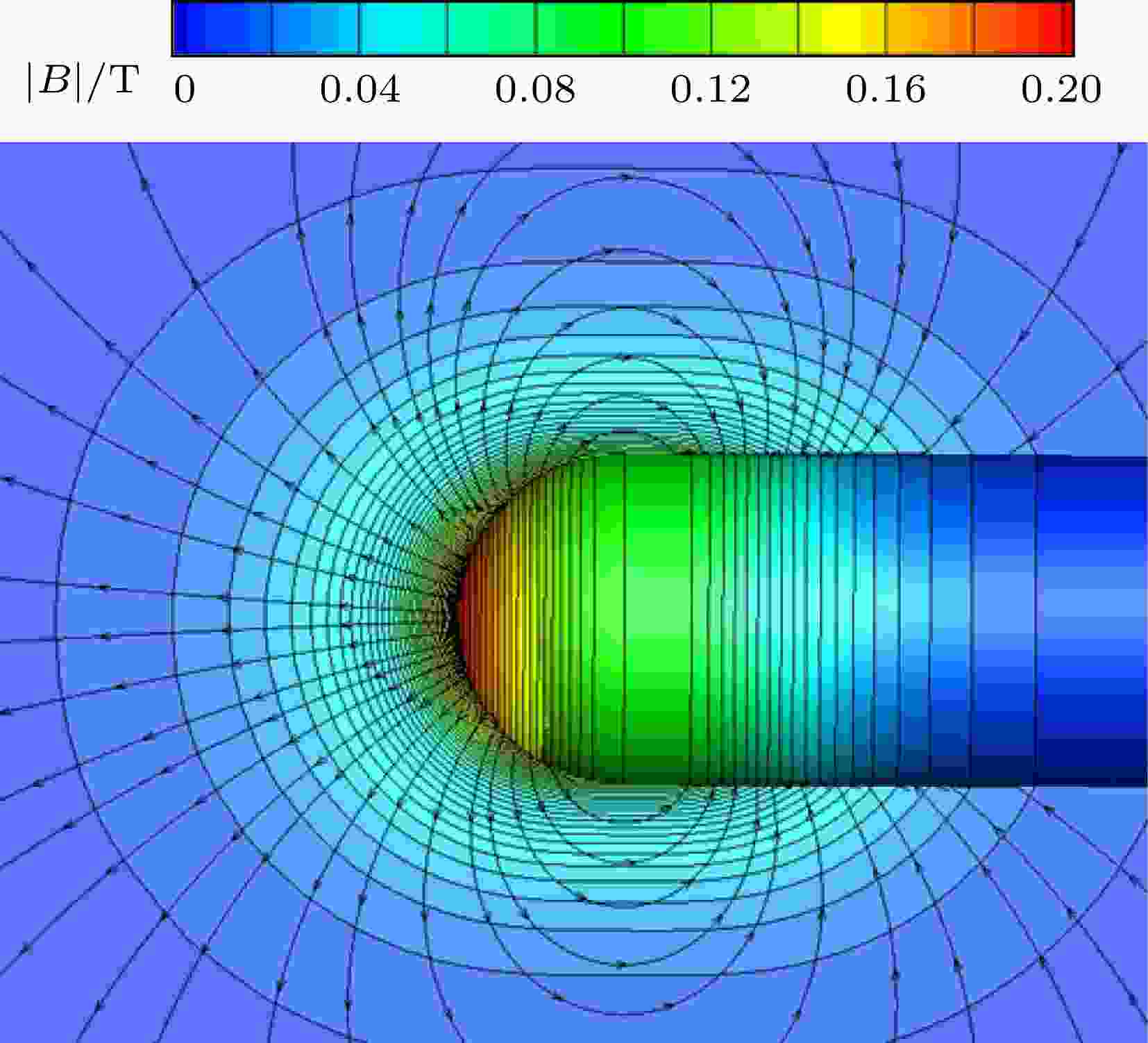
2019, 68 (17): 174702.
doi:10.7498/aps.68.20190378
Abstract +
PHYSICS OF GASES, PLASMAS, AND ELECTRIC DISCHARGES

2019, 68 (17): 175201.
doi:10.7498/aps.68.20190484
Abstract +
Femtosecond electron bunches can be produced by laser plasma wakefield accelerators, with energy tunable from tens of MeV to a few GeV. In order to produce stable mono-energetic electron bunches, a critical issue is to control the injection of electron into the wakefield. The ionization injection is one of the most effective methods of controlling the injection, which is usually a continuous process. So, the electron bunches produced through ionization injection usually possess large energy spread. In order to optimize the ionization injection technique and produce stable monoenergetic wakefield electron beams, experimental studies are conducted on our 45 TW laser facility. In this work, a mixed injection mechanism assisted cascaded laser wakefield accelerator is presented. Based on a double-nozzle cascaded accelerator, the influences of ionization injection, shock wave front injection and their combination are experimentally studied. The results show that the lower threshold of the injection can be substantially reduced. The ionization injection is restricted within the shock wave front. As a result, mono-energetic electron bunches with reduced absolute energy spread can be stably produced. Under the most optimal conditions, the central energy and energy spread are (63.24 ± 6.12) MeV and (13.0 ± 3.9) MeV. The charge quantity of the electron bunches is (5.99 ± 3.10) pC. The minimum emitting anglular spread is (3.6 × 3.8) mrad.
CONDENSED MATTER: STRUCTURAL, MECHANICAL, AND THERMAL PROPERTIES
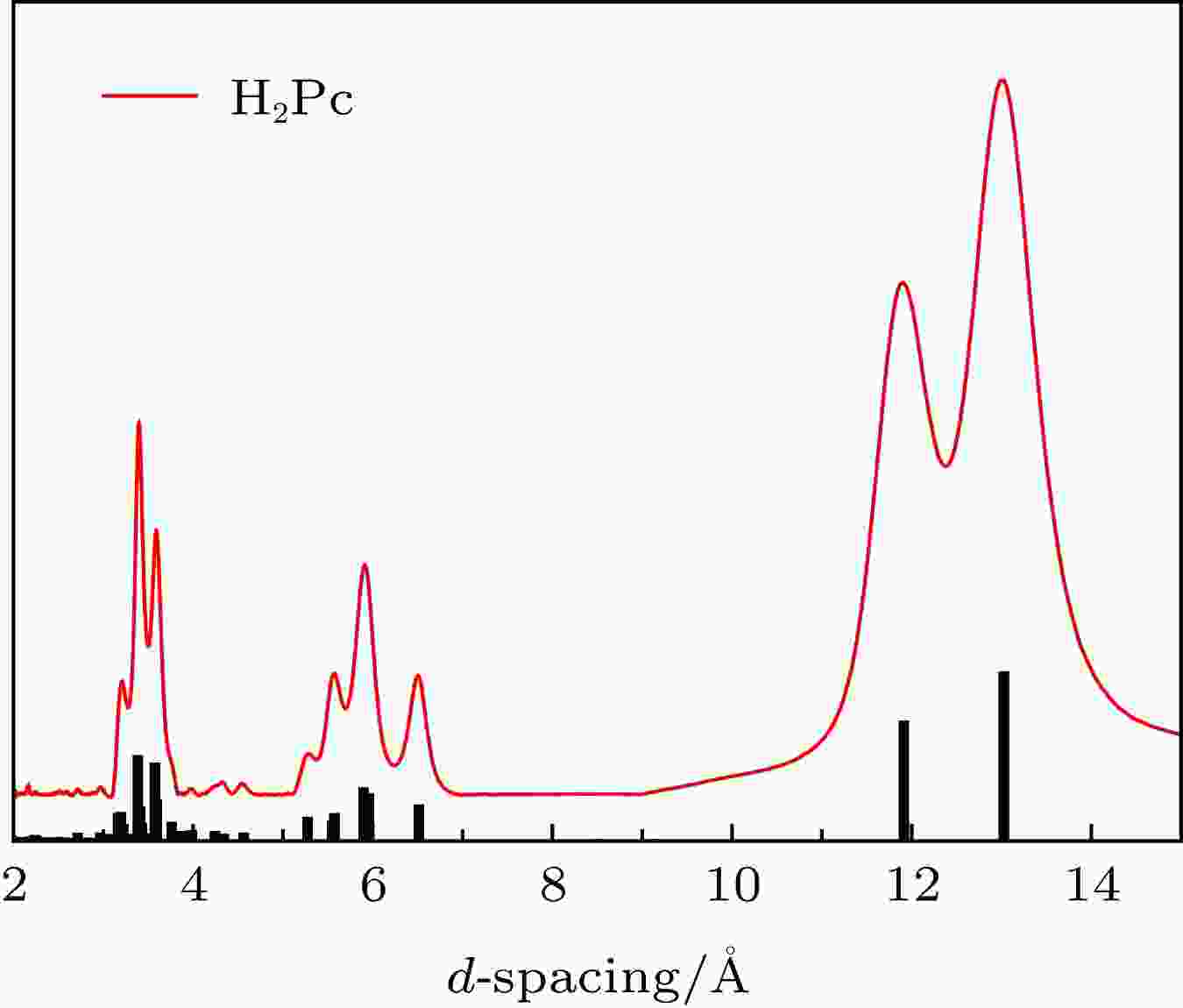
2019, 68 (17): 176101.
doi:10.7498/aps.68.20190559
Abstract +
Phthalocyanine (Pc) is a kind of important photoelectric material, but a lot of questions remain to be clarified, like the relationship between the structure of Pc and its photoelectric property. High pressure is a powerful tool to study the structure transformation. High pressure study on piezochromic materials, which shows color change under high pressure due to structure changing, serves as an effectively way of studying the relationship between materials’ structure and photoelectric property. In this work Raman spectrum is employed to study the phase change of α phase metal-free Pc (α-H2Pc) under high pressure, meanwhile the effect of pressure on fluorescence (FL) is also studied to show how the Pc’s structure affects the photoelectric property. The diamond anvil cell is employed to achieve the high pressure condition, by using NaCl as a pressure transmitting medium. And Raman and FL measurements are performed by using a LabRam HR Evolution spectrometer equipped with a 473 nm laser. The Raman spectra of α-H2Pc show to slightly change during compression to 12.0 GPa. The main Raman peaks remain at highest pressure, including the Raman peak from macrocyclic of Pc molecules, which shows the stability of Pc molecules. Note that an enhancement of Raman peak at 623 cm–1can be found with the pressure increasing, which appears only in the Raman spectrum of χ phase metal-free Pc (χ-H2Pc), showing that α-H2Pc is converted into χ-H2Pc under pressure. The curve for Raman frequency as a function of pressure shows that no obvious evidence related to bonding or structure transition can be observed, which means that α-H2Pc is transformed into χ-H2Pc gradually. For FL spectrum, only the FL of excimer can be found in α-H2Pc at atmosphere pressure. When the solid α-H2Pc is compressed, the FL intensity is found to decrease as pressure increases, and it is quenched at 3.0 GPa. The FL of Pc molecule, which is not found in α-H2Pc at ambient pressure, appears at 0.7 GPa. As the pressure increases, the FL intensity ratio between Pc molecule and excimer is enhanced. Considering the pressure induced phase transition from α-H2Pc to χ-H2Pc gradually, the change in FL spectrum should be due to the structure transformation. It is proved that the degree of overlapping between Pc molecules in α-H2Pc is larger than that in χ-H2Pc. We think, the degree of overlapping decreases under high pressure, which hinders the formation of excimer. It makes the excimer emission decrease and the FL of Pc molecules appear under high pressure. Our work can explain the relationship between Pc crystal structure and its fluorescence, reveals the kinetic behavior of macromolecules similar to Pc system under high pressure, and provides a new possibility of designing the photoelectric materials with excellent performances.

2019, 68 (17): 176301.
doi:10.7498/aps.68.20182305
Abstract +
As the demand for electronic devices increases continually, the spintronic materials have played an important role in materials science and electronics. Spintronic devices have excellent properties such as non-volatility, low power consumption, and high integration compared with conventional semiconductor devices. In this paper, we investigate the electronic structure, magnetic and optical properties of the semiconductor GaSb doped with 3d transition metal Cr, based on first-principles calculations. The compounds are constructed by replacing some Ga atoms with Cr in zinc-blende GaSb semiconductor, where the concentrations of the Ga atoms replaced are 0, 0.25, 0.50, and 0.75. We adopt the projected plane wave method and the electronic exchange correlation functional PBE in the generalized gradient approximation. Band gap is modified by Heyd-Scuseria-Ernzerhof (HSE06) functional. We study the equilibrium lattice constants of Cr-doped GaSb in zinc-blende structure at different concentrations. The energy of nonmagnetic, ferromagnetic and antiferromagnetic states at the equilibrium lattice constants are compared to identify the ground state. For Ga1–xCrxSb (x= 0.25, 0.50, 0.75), we find that the most stable state is ferromagnetic state. In the electronic structure of the ground state, the spin-up bands pass through the Fermi level while the spin-down bands each have a direct band gap. The Ga1–xCrxSb exhibit ferromagnetic half-metallic properties. The magnetic properties at different lattice constants under different concentrations are studied. Our analysis indicates that the Ga1–xCrxSb have integer Bohr magnetic moments of 3.0, 6.0, 9.0μBforx= 0.25, 0.50 and 0.75, respectively. We find that when the lattice changes fom –5% to 20%, the total magnetic moment for each of Ga1–xCrxSb still remains the integer Bohr magnetic moment, and the magnetic moment of the Cr increases with the lattice constant increasing. We also find that the ferromagnetisms of Ga1–xCrxSb have Curie temperatures above room temperature, estimated by mean-field method. The p-d electron hybridization occurs in Cr-3d orbital and Sb-5p orbital, and the electron state density distribution of Cr-3d is transferred, that is, the electron orbital hybridization makes the total electron state density of crystal material redistributed, which is the main reason why Ga1–xCrxSb (x= 0.25, 0.50, 0.75) present ferromagnetic half-metallic properties. Additionally, the Ga1–xCrxSb have good absorption ability in the infrared region, compatible with zinc-blende semiconductors such as GaSb, which makes Ga1–xCrxSb have promising potential applications in both spintronic devices and infrared optoelectronic devices.
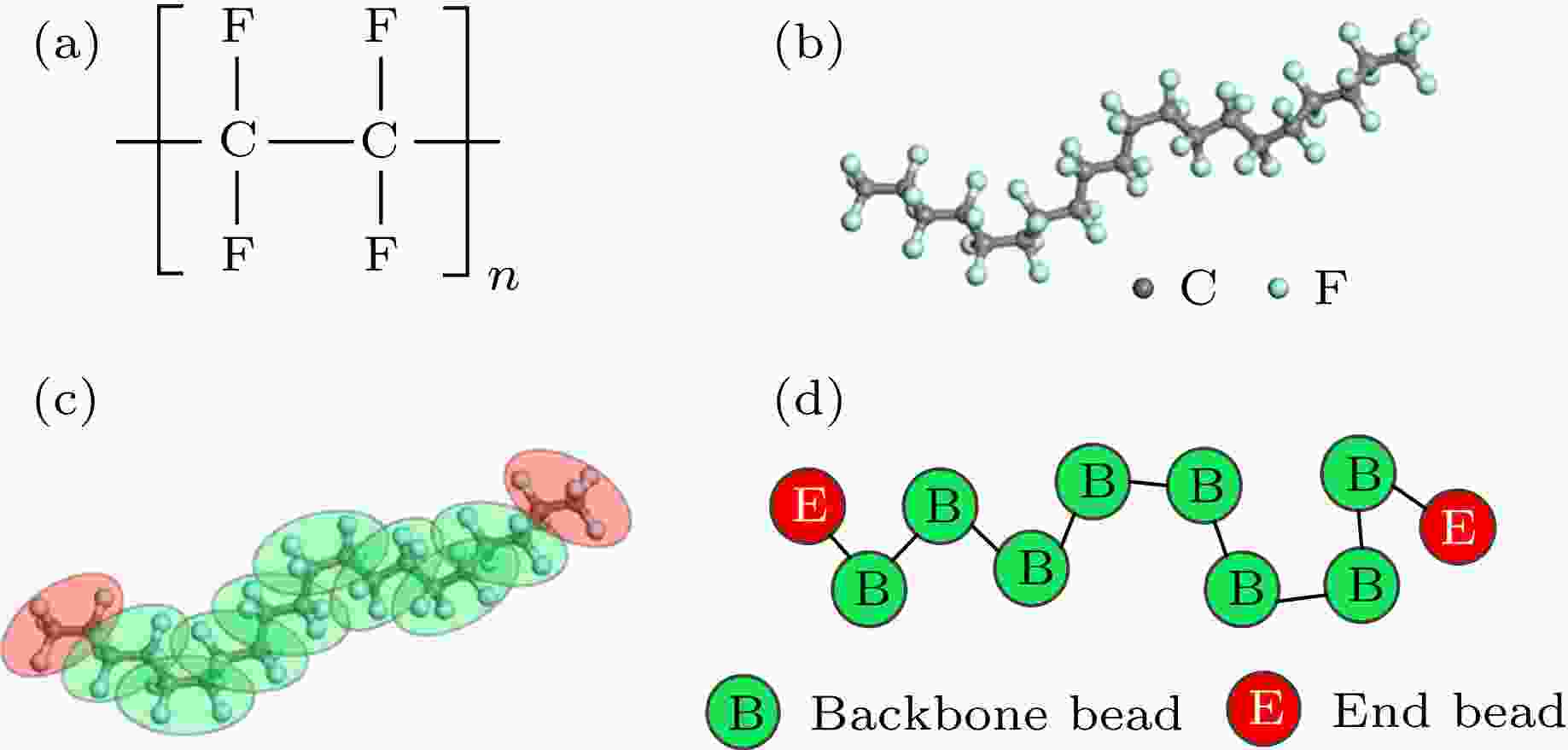
2019, 68 (17): 176801.
doi:10.7498/aps.68.20190495
Abstract +
CONDENSED MATTER: ELECTRONIC STRUCTURE, ELECTRICAL, MAGNETIC, AND OPTICAL PROPERTIES
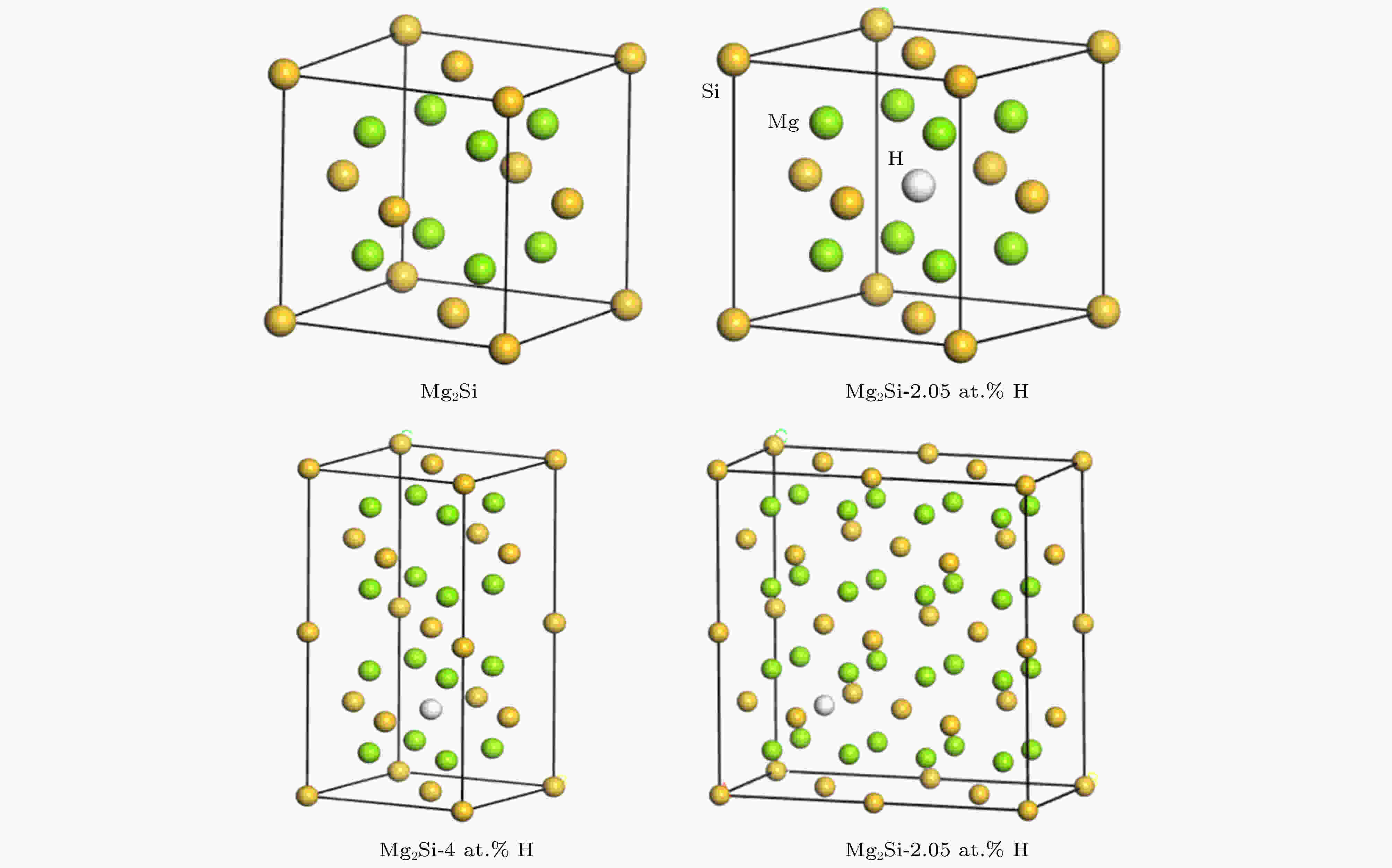
2019, 68 (17): 177102.
doi:10.7498/aps.68.20190368
Abstract +
The mechanical properties of Al-Mg-Si-type aluminum alloys may degenerate due to the hydrogen damage during servicing in hydrogen environment. The Mg2Si is the main strengthening phases in Al-Mg-Si-type aluminum alloys. Therefore, the mechanical properties of Mg2Si directly determine the strengths of Al-Mg-Si-type aluminum alloys. In this work, the effects of hydrogen atoms on the mechanical properties of Mg2Si are investigated by first principle calculation, which is based on the density function theory. First of all, we calculate the single crystal elasticity constants ofC11,C12andC44. Then the elasticity modulus, Poisson’s ratio and hardness of polycrystalline are calculated by using the crystal elasticity constants. Furthermore, we also calculate the tensile properties of Mg2Si with and without H atoms. The difference between the densities of states with and without H atoms is used to investigate the change of Mg2Si induced by H atoms. The results show that hydrogen atoms significantly reduce the shear modulus and elastic modulus of Mg2Si, resulting in the strength and hardness decreasing, but the toughness increasing. The calculations of tensile properties indicate that H atoms reduce the fracture strength but enhance the fracture elongation of Mg2Si. The analysis of density of states indicates that hydrogen atoms will induce the properties of Mg2Si to transform from semiconductor to metal properties. The calculated results in this paper can provide a reference basis for revealing the mechanism of strength reduction of Mg2Si materials in a hydrogen environment.
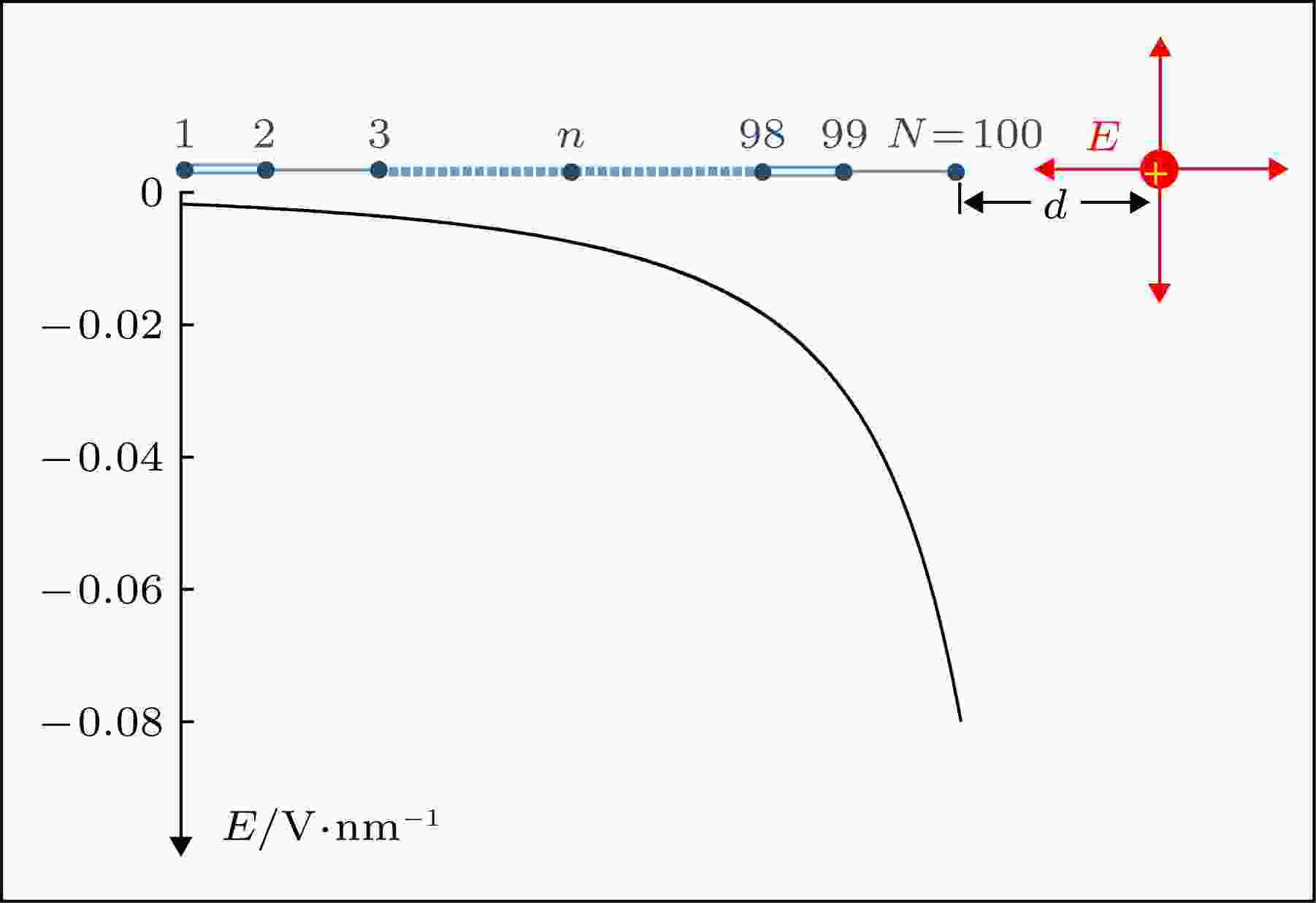
2019, 68 (17): 177201.
doi:10.7498/aps.68.20190432
Abstract +
Due to the exciton migration dynamics playing an important role in the photovoltaic process of organic solar cells, which are usually composed of polymer donor and fullerene (or non-fullerene) acceptor, in this paper we propose a new strategy to achieve the ultrafast exciton migration in polymers. Here, the effects of some nonuniform fields on the exciton migration dynamics in polymers are emphasized, such as the nonuniform electric field and the nonuniform polymer packing configuration field. Both of the two kinds of nonuniform fields can be intrinsically existent or modulated in an actual photovoltaic system. In this work, the nonuniform electric field and the nonuniform configuration field are assumed to be separately created by a confined charge and a linear polymer packing, therefore, their model Hamiltonian is established. In dynamical simulations of the exciton migration dynamics in polymers, an extended version of one-dimensional Su-Schrieffer-Heeger tight-binding model combined with a nonadiabatic evolution method is employed. It is found that the nonuniform electric field and the nonuniform configuration field both can drive exciton to an ultrafast migration process. Compared with the exciton migration speed dominated by the traditional Förster or Dexter mechanism, the exciton migration speed dominated by the nonuniform electric field and that by the nonuniform configuration field can be increased by one and two orders of magnitude, respectively. In addition, the driving mechanisms of the two kinds of nonuniform fields for the exciton migration dynamics are separately clarified, where the corresponding driving forces are also quantitatively calculated. Finally, in view of the factors affecting the distributions of the two kinds of nonuniform fields (such as the distancedbetween confined charge and polymer, and the linear packing slopekbetween polymers), we discuss their effects on the exciton migration dynamics. It is found that the exciton migration in polymer can be apparently accelerated by shortening the distancedbetween confined charge and polymer, and there exists a critical value ofd, beyond which the exciton will be dissociated into free charges in its migration process. For the linear packing slopekbetween polymers, we find that there exists an optimal value, at which the exciton has the highest migration speed in polymers.
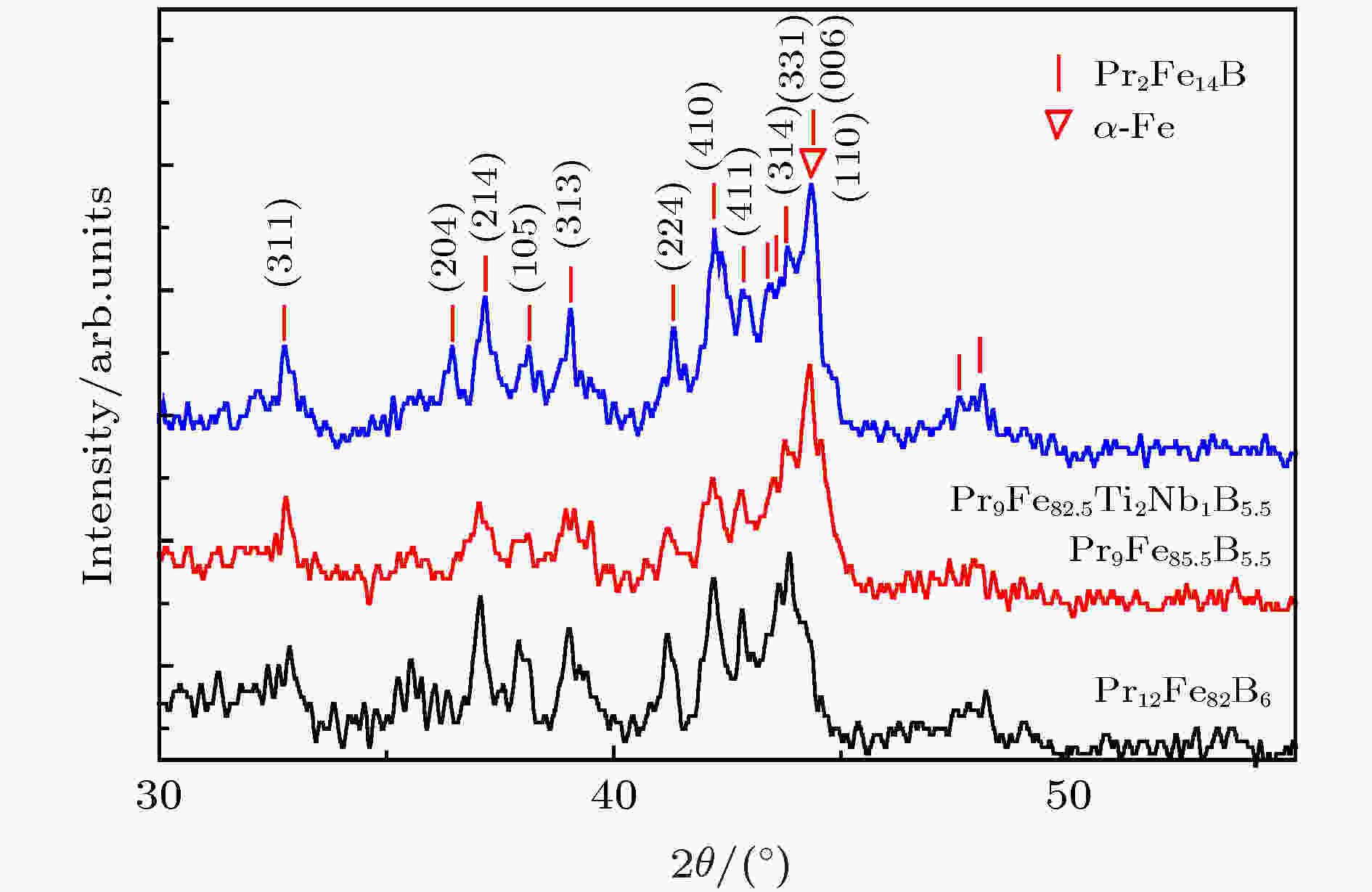
2019, 68 (17): 177501.
doi:10.7498/aps.68.20190364
Abstract +
The coercivities in rare earth permanent magnets even with the same intrinsic properties may differ largely. In this paper, what determines the coercivity is discussed via the investigation of thermal activation in Pr-Fe-B ribbons prepared by melt-spinning method. The thermal activation, resulting from thermal fluctuation overcoming the energy barrier under the applied field, is the critical behavior of magnetization reversal. The activation size is comparable to the theoretical domain wall size, implying that the magnetization reversal undergoes the nucleation of revered domain wall at grain outer-layer in Pr-Fe-B ribbons, and the defects near the grain boundary are critical for the magnetization reversal and coercivity. The exchange coupling between the defect region at grain outer-layer and the perfect region in the inside of grain promotes the nucleation of reversed domain and the depinning of domain wall motion. The reduced anisotropy of the defect region also contributes to the overcoming of energy barrier of magneto crystallie anisotropy in the inside of Pr-Fe-B grains by the coupling effect, so the nucleation field of reversed domain and coercivity decrease largely, and the domain wall size is a little larger than the theoretical value due to the coupling between the defect region at grain outer-layer and the perfect region in the inside of grain in the critical magnetization reversal. In Pr2Fe14B/α-Fe composite magnets, the exchange coupling between the soft and hard magnetic phase leads the domain wall size to increase in the critical magnetization reversal of thermal activation, and so the exchange energy plays a role in overcoming the energy barrier, resulting in the further decrease of coercivity. Via the addition of Ti and Nb element, the coercivity increases significantly. Based on the investigation of thermal activation, the size of defect region involved in the domain wall decreases, and the contribution of the anisotropy in the defect region and interface to the overcoming of energy barrier is weakened, so the applied magnetic field should be increased in the magnetization reversal. The coercivity can be enhanced by reducing the size of defect region at grain outer-layer and by making the anisotropy change abruptly at the interface between the hard and soft magnetic phase.
INTERDISCIPLINARY PHYSICS AND RELATED AREAS OF SCIENCE AND TECHNOLOGY

2019, 68 (17): 178101.
doi:10.7498/aps.68.20190035
Abstract +

2019, 68 (17): 178102.
doi:10.7498/aps.68.20190416
Abstract +
Mixture gas arcs are used extensively in welding manufacturing. A two-dimensional steady mathematical model for Ar-O2mixture gas arc is developed to understand further the heat and mass transfer of the mixture gas arc. The model is based on the assumption of local thermodynamic equilibrium, and the thermodynamic parameters and transport coefficients are dependent on both the temperature and the oxygen content. In the present model, the diffusion between the argon species and oxygen species is depicted by the approach of the combined diffusion coefficient, i. e. the mixture gas arc is simplified into two different species, and the diffusion between them is formulated by combined ordinary diffusion coefficient and combined temperature diffusion coefficient; the oxygen distribution and its influence on the temperature and flow field of the arc are investigated for two different current conditions. It is shown that the oxygen species presents significant non-uniform distribution for argon gas mixed with 5% oxygen; the oxygen content is higher than that in mixed shielding gas in the regions close to the electrodes and arc axis, while its content is lower than that of the mixed shielding gas in other regions. For high current, oxygen concentrates more to the flat anode, while it concentrates more to tungsten cathode for low current. For both cases, oxygen content is inhomogeneous in the region 0.1 mm above the anode. The 5% oxygen mixed in argon constricts the arc plasma to some extent and thus raises the arc temperature as well as the plasma flow velocity.
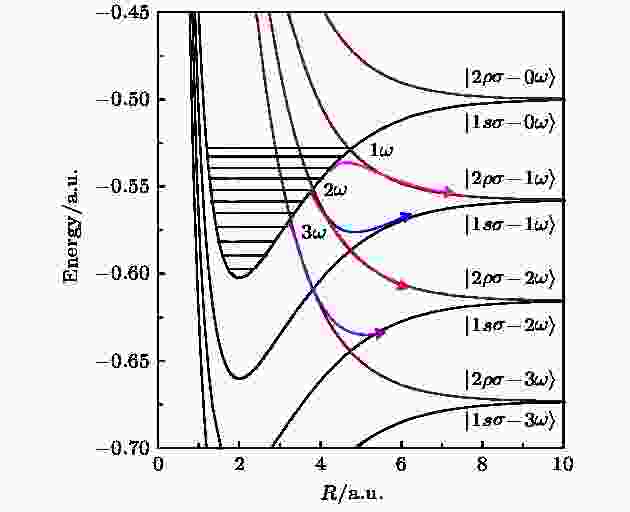
Theoretical study of dissociation dynamics of HD+and its quantum control with an intense laser field
2019, 68 (17): 178201.
doi:10.7498/aps.68.20190400
Abstract +
The dissociation dynamics of HD+molecule in an intense field is investigated by using an accurate three-dimensional time-dependent wave packet approach. When the 790-nm laser pulse interacts with HD+molecule, the lowest electronic 1sσ and 2pσ states are coupled. Due to the existence of the permanent electric dipole moment, the transitions in HD+molecule involve the direct absorption of an odd and even number of photons, thereby opening different pathways for dissociation. The model of the photon-dressed states is presented to analyze the possible dissociation pathways of HD+molecule. The laser-induced dissociation of HD+molecule is mainly composed of the four pathways: the direct one-photon absorption, the net two-photon absorption, the direct two-photon absorption, and the direct two-photon absorption. To reveal the dissociation mechanism of HD+molecule, the kinetic energy resolved spectra are calculated at the given laser intensities. It is found that the dissociation pathways are strongly dependent on laser intensity, especially for the net one-photon absorption dissociation and direct two-photon absorption dissociation. With further research, the dissociation pathways of HD+are controlled by regulating the intensity of laser pulse. At a laser intensity of 4.0 × 1013W/cm2, the kinetic energy resolved spectrum for the vibrational stateν= 3 includes the contributions from the net two-photon absorption dissociation and the direct two-photon absorption dissociation. For the vibrational stateν= 6, HD+molecule is preferentially dissociated via the net one-photon absorption. However, the dissociation mechanism of HD+molecule at the vibrational statesν= 3 andν= 6 have significant changes as the laser intensity increases to 2.0 × 1014W/cm2. For the vibrational stateν= 3, the branching ratio between the dissociation pathway of the net two-photon absorption and that of the direct two-photon absorption has a dramatic change with the increase of laser intensity. Compared with the kinetic energy resolved spectra at laser energy of 4.0 × 1013W/cm2, the height of the dissociation peak from the net two-photon absorption decreases, and that of the direct two-photon absorption increases at laser intensity of 2.0 × 1014W/cm2. For the vibrational stateν= 6, the dissociation process of the net one-photon absorption almost disappears at laser intensity of 2.0 × 1014W/cm2, and it is replaced by the dissociation pathway of the direct two-photon absorption.

2019, 68 (17): 178401.
doi:10.7498/aps.68.20190535
Abstract +
The post-hole convolutes (PHCs) are used in pulsed high-power generators to add the output currents of the magnetically insulated transmission lines (MITLs) and deliver the combined current to a single MITL. Then the single MITL delivers the combined current to the load. Magnetic insulation of electron flow is lost near the post-hole convolute (PHC) in the high-power generator. Although cathode plasma and anode ions are widely considered as the factors of the magnetic insulation collapse, there are some other factors that are needed to study. In this paper, the cathode negative ions are considered in the PIC simulation of a single-hole PHC. In this work, we examine the evolution and dynamics of the negative ions in the PHC. The simulation results demonstrate that there are no current losses while the cathode emits only electrons, little current losses (10 kA out of a total current of 900 kA) while the cathode emits plasma including electrons and ions, and obvious current losses (20 kA out of a total current of 900 kA) while the cathode emits plasma including the electrons, ions and negative ions. The results also indicate that the velocity of the negative ions is about 10 cm/μs, larger than that of the cathode plasma including the electrons and the ions. All results suggest that the cathode negative ions can play an important role in the magnetic insulation collapse, and should be considered carefully in experiment.
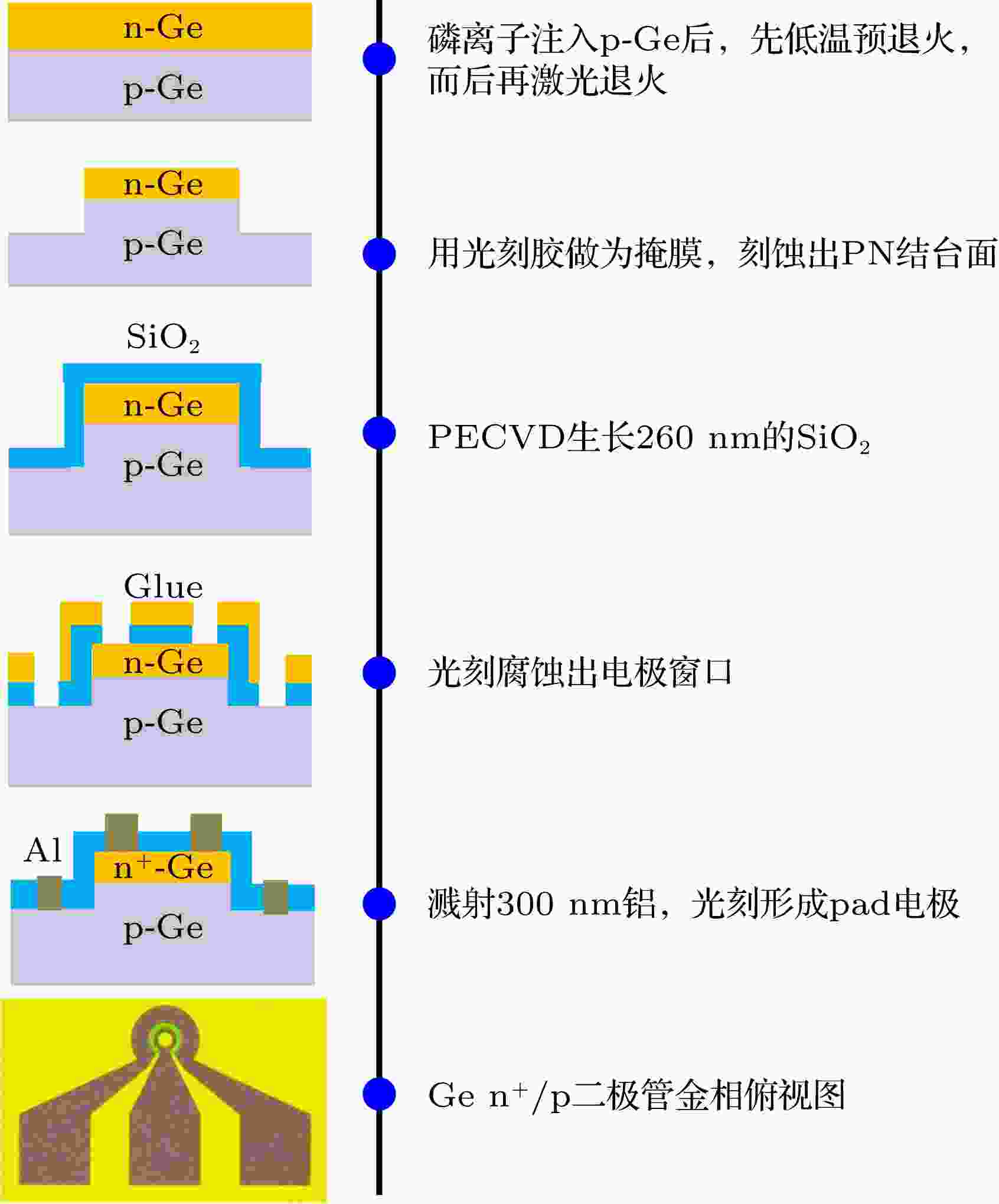
2019, 68 (17): 178501.
doi:10.7498/aps.68.20190699
Abstract +
Silicon based germanium devices are crucial parts of optoelectronic integration as CMOS feature size continuously decreases. Germanium has attracted increasing attention due to its higher electron and hole mobility, larger optical absorption coefficient as well as lower processing temperature than those of silicon. However, the high diffusion coefficient and low solid solubility about n-type dopant and relatively high thermal budget required for high n-type doping in Ge make it difficult to achieve high activation n-type doping and excellent n+/p shallow junction for source/drain in the nano-scaled n-MOSFET (here MOSFET stands for). The high activation concentration and shallow junction n-type doping in Ge are greatly beneficial to the scaled Ge n-MOSFET technology. In this work, the ohmic contact of Al/n+Ge and Ge n+/p junction fabricated by a combination of low temperature pre-annealing process and excimer laser annealing for phosphorus-implanted germanium are demonstrated. Prior to excimer laser annealing, the samplesare annealed at a relatively low temperature, which can heal the implantation damages preliminarily. Through the optimization of pre-annealing temperature and time, the low temperature pre-annealing step can play a critical role in annihilating the implantation damages and significantly suppressing phosphorus diffusion in the laser annealing process, resulting in a very small dopant diffusion length at a high activation level of phosphorus. Through the combination of ion implantation and two-step annealing technology, the specific contact resistivity (ρC) of Al/n+Ge Ohmic contact is measured by CTLM structure. The optimized annealing condition is 400oC-10 min of low temperature annealing and 150 mJ/cm2of ELA. Under that annealing condition, the ρCof the sample by two-step annealing is reduced to 2.61 × 10–6Ω·cm2, which is one order of magnitude lower than that by ELA alone (about 3.44 × 10–4Ω·cm2). The lower value ofρCfor the sample with LTPA can contribute to the higher carrier concentration and better crystalline quality thanthat without LTPA, which is confirmed by SRP and TEM. Moreover, the rectification ratio of Ge n+/p junction diode is improved to 8.35 × 106at ± 1 V, which is two orders of magnitudes higher than that by ELA alone. And a lower ideality factor of about 1.07 is also obtained than that by ELA alone, which indicates that the implantation damages can be repaired perfectly by two-step annealing method.
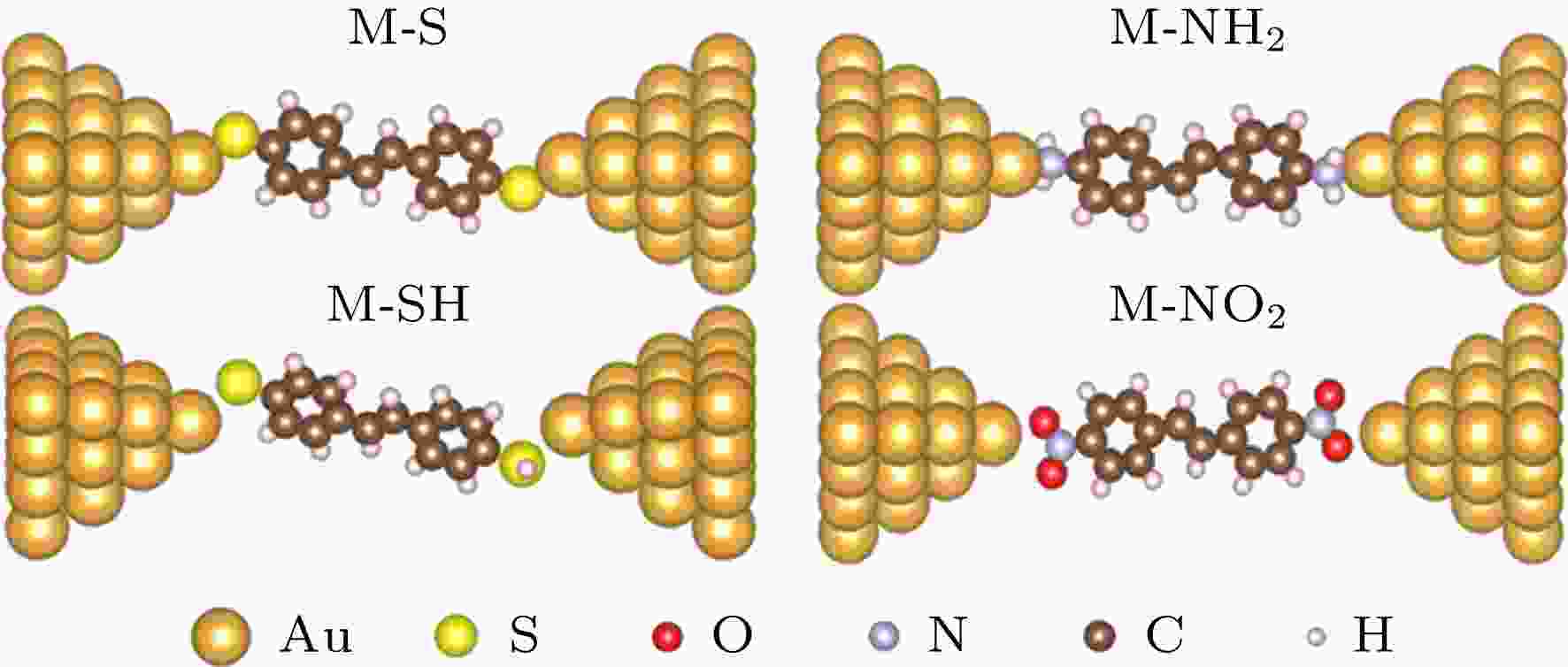
EDITOR'S SUGGESTION
2019, 68 (17): 178502.
doi:10.7498/aps.68.20190693
Abstract +
The stretching and breaking processes of stilbene-based molecular junctions, which contain S or N atoms in the terminal groups, are studied by using density functional theory. The numerical results show that for pyramid-shaped gold electrodes, a stretching force of about 0.59 nN is needed to break the molecular junction with —S terminals, which is larger than the force of 0.25 nN that is required by the molecule to stretch —SH terminals away from pyramid-shaped gold electrode. However, it is obviously smaller than the force of about 1.5 nN that is needed by the molecule to break —S terminals from planar-shaped gold electrode. If the terminal group is —NH2or —NO2, the force for breaking the molecular junction is about 0.45 nN or 0.33 nN, respectively. More delocalized molecular orbitals formed by the coupling between the frontier occupied orbitals of molecule and electrodes, higher stretching force for breaking molecular junction is required. The natural bond orbital (NBO) analysis shows that more NBO net charges that the terminal atom possesses can enhance the stability of the molecule-electrode contact if there is no bonding orbital formed between end group of molecule and electrode. Based on the numerical results and the combination with previous studies, it can be found that —S terminal and —NH2terminal show evident properties in distinguishing tip structures of gold electrodes, which provides useful information for precisely controlling the interactions and interface structures between molecule and electrodes.

2019, 68 (17): 178701.
doi:10.7498/aps.68.20190372
Abstract +
The complex fluctuation of heart rate variability reflects the autonomous regulation function of the heart. In this paper, a novel method of measuring the heart rate variability is proposed. Firstly, the heart rate variability signal is decomposed by the improved complete ensemble empirical mode decomposition with adaptive noise method, and the multiple intrinsic mode functions are obtained, and the bubble entropy of each intrinsic mode function is calculated to obtain an entropy value vector. Then, the vector is mapped to a network based on a limited penetrable horizontal visibility graph method. By calculating various characteristic parameters of the network, the coupling relationship between the nonlinear features of heart rate variability in different time-frequency scale states are studied. The characteristic parameters include mean value of aggregation coefficient (MC), the characteristic path length (CL), the topological entropy of network (TE), the network level weighted bubble value (WB), and the pseudo mean value of node weight (PW). Firstly, the heart rate variabilities of 29 patients with congestive heart failure and 29 normal sinus heart rhythm subjects are analyzed by time domain, frequency domain and ICBN analysis method, theTtest is used for statistical analysis, and Fisher discriminant method is used for classification. The results show that the time domain triangular index HRVTI, frequency domain index LF/HF, WB, PW and CL in ICBN have statistical differences. The accuracy rate of recognition model based on WB, CL, frequency domain index LF/HF and Fisher discriminant method is 89.66%. Secondly, the heart rate variabilities of 43 patients with atrial fibrillation arrhythmia and another 43 normal sinus heart rhythm subjects are analyzed by the same methods, including the time domain analyzed method, frequency domain analyzed method, and ICBN analyzed method. Then, the T test is also used for statistical analysis, and Fisher discriminant method is used for classification. The results show that using the time domain index pNN5 and RMSSD, frequency index LF/HF, ICBN index WB and PW as the feature vectors, and the Fisher discriminant mode as the classifier, the accuracy rate of recognition for atrial fibrillation arrhythmia is 91.86%. From these results it is concluded that the ICBN method provides a new idea for the heart rate variability measurement.
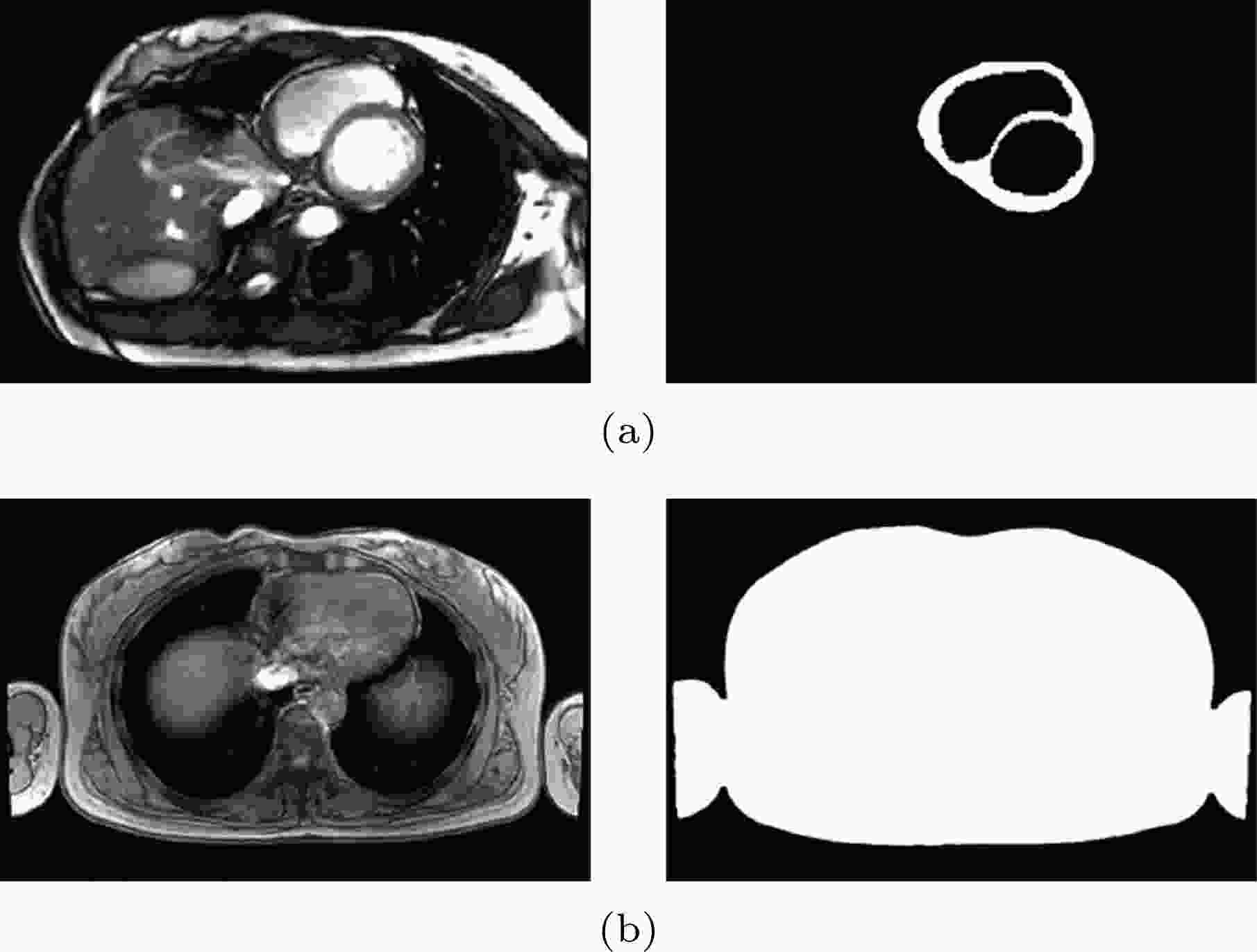
2019, 68 (17): 178702.
doi:10.7498/aps.68.20190387
Abstract +
In order to simulate the distribution of magnetic field generated by cardiac electrophysiological activities, a three-dimensional (3D) computing framework of magnetocardiogram forward problem based on a finite element method (FEM) is proposed. First, the 3D heart-torso geometry model is established from the 3D reconstruction of magnetic resonance images. Then the modified FitzHugh-Nagumo (FHN) equation combined with 3D cardiac geometry is used to investigate the propagation of transmembrane potential (TMP). In the end, quasi-static Maxwell equations and 3D torso model are used to explore the propagation of the bioelectromagnetic field produced by TMP. In our calculation, the Galerkin finite element method is used. The results show that the FEM-model can simulate extracorporeal magnetic field. Further, numerical solutions of simplified models with the one-dimensional FHN equation and the straight wire are respectively consistent with the analytical solutions, which verifies the feasibility of the computing framework. In summary, this framework successfully simulates the cardiac TMP and extracorporeal magnetic field, which may conduce to the study of magnetocardiogram inverse problem.









